Lately, I’ve been focusing on my Pasta Madre a lot. While studying it and playing around with different flours I generated a considerable amount of pasta madre discards. Of course, I found a way to repurpose them instead of throwing them away. I made this fantastic sourdough fougasse with olives and thyme that is going to blow your taste buds! This is the most aromatic sourdough fougasse I’ve ever made! It’s definitely a delicious treat to share and a fantastic appetizer to keep your guests happy while dinner is finishing cooking!

What is fougasse bread?
In a world full of focaccias, baguettes, and sourdough loaves it’s easy for this incredibly delicious bread to go unnoticed. Let me tell you a bit about it!
Fougasse is a French bread typical from Provence although it has more variants in other regions of France. It’s somehow a flatbread and it’s shaped in an irregular shape with slits in the middle. In France is very common to add fillings such as olives, cheese, anchovies…
FUN FACT! this bread was originally used to test the temperature of the wood fire ovens they had back in the day. The bakers could estimate the temperature based on how long it took to bake a fougasse. So there you have it, delicious bread full of tradition!
What is pasta Madre?
In case you’re not familiar with it, let me make a quick summary of what pasta madre is: It’s a special stiff starter used in the making of Grandi Lievitati products, namely Panettone, Pandoro, Colomba… I said special because it’s not *just* a stiff stater. Pasta madre, (or lievito madre, or lievito naturale in some cases) is typically maintained under pretty specific conditions and methods. The method I use is the one where the starter is kept in water. The other method wraps the pasta madre and keeps it tied.
If you want to learn more about it you can check this post to learn how to create your own lievito madre, this post for information about the 3 preparatory refreshments before making panettone, and this post for a mini-guide to troubleshoot your pasta madre.
Stiff starter vs. Pasta Madre, two different things
Social media has done a very poor job of explaining what Pasta Madre is. And frequently people use starters at 60% hydration and call them Pasta Madre. But a real pasta madre s about 35-45% hydration (depends on the flour). And it has a very controlled maintenance process in order to keep a healthy ratio of bacteria and yeasts and promote specific types of LAB. The purpose of this special maintenance is to make a panettone (Grandi lievitati) that is very very very soft, packed with flavor, that can stay fresh for many days and that has not a single hint of acidy nor acidifies over time. Not just to leaven the dough.
Why do I generate so many pasta madre discards?
The thing is… because Pasta Madre is kept either in water or tied up, you can’t really use small amounts of flour because otherwise it’d disintegrate in the water very quickly or it’ll completely dry out in the cloth. My normal maintenance amounts are:150-200g of pasta madre, 150-200g of very strong flour, and 70-80g of water.
Basically, I generate about a pound of pasta madre discards every 24h. And that is a lot of perfectly fine and very strong pasta madre that could be used for other things. I usually keep it in the fridge and accumulate it over a few days and use it to make crackers. I also use it for sourdough loaves, or to make these delicious orange and cinnamon rolls.
And now we have another recipe! This sourdough fougasse is good! Trust me on this! And it uses about all the discard from one refreshment.
If you are using pasta madre discards, I recommend you start the fougasse dough right after the last maintenance refreshment. That is when the pasta madre is at its peak of activity.
Is this a sourdough discard recipe?
Yes, because pasta madre is still sourdough, and a very active one! It’s still a dough packed with wild yeasts and bacteria. And like sourdough discards, you can use it in pretty much anything! It’s also great for stiffer dough, you can use it to make bread like this sourdough challah, or my sourdough burger buns… The options are endless here!

What if I don’t have pasta madre?
Don’t worry! If you don’t have pasta madre you can either create a stiff starter and use it, or use your liquid sourdough starter (100% hydration), I got you!
How to create a stiff starter with your 100% hydration starter
I’m going to show you how to make a shortcut stiff starter at 55% hydration because if we lower the hydration too much, your bacteria will end up a bit stressed and there’s a chance it won’t be active enough to use. You can read all about adaptation periods and water content on this post. It’s about the science of your sourdough starter (without fancy words and easy to follow).
A 55% hydration starter would be very easy to make by mixing 100g of flour with 55g of water. But this will make a total of 155g of starter. We don’t need that much, so we need to scale it down to a total of 100g. So we need to scale down.
| Ingredients | For 155g of starter | For 120g of starter | For 100g of starter |
| Total Flour | 100g | 77.4g | 64.5g |
| Total Water | 55g | 42.6g | 35.5g |
Pay attention to the water
Now, water is our limiting factor here because we just need a little amount. Since we’re using our 100% hydration starter, that means that whatever weight of this starter is made of 50% flour and 50% water.
So, let’s say you want to make 120g of stiff starter (just to play safe). That starter will have 42.6g of water. This water comes ONLY through your liquid starter. Since water is only 50% of the liquid starter, we will need twice the amount. And then to make it stiffer we just add the flour difference. Let me show you!
Twice the amount of 42.6g (of water we need) is 85.2g. We need to take 85.2g of liquid starter (42.6g of water, and 42.6g of flour). And according to the table above, to make 120g of stiff starter we need a total of 77.4g of flour. From our liquid starter, we already have 42.6g of flour. The difference we need to add is: 77.4 – 42.6 = 34.8g
Let me do the math for you!
Too much math for a beautiful day such as this one? Then let me do the numbers and just pick on the table below the amount of starter you prefer to make:
| Ingredient | For a total of 120g of stiff starter | For a total of 100g of stiff starter |
| 100% hydration starter | 85.2g | 71g |
| Extra flour | 34.8g | 29g |
You can now pick how much stiff starter you want and mix the ingredients. Knead the dough by hand for a couple of minutes. You don’t need to develop the gluten perfectly but make sure there aren’t dry flour particles or dry chunks of dough. The idea is to have a dough that is stiff but workable and not sticky. Aim for a bagel dough kind of consistency.
Once mixed put it in a container with a loose lid and wait until at least doubles in size. It’d be helpful to have a narrow and taller container rather than a wider and shorter one. That way it’ll be easier to see how much it grows. Once you see it doubles wait for a while, if it stalls then it’s at the peak, if it continues growing then it’s not at the peak yet. Wait a bit longer and test again.
You also need an active starter to make sure the stiff starter can grow fast and you don’t need to refresh it again to make it stronger. Remember, the purpose of this recipe is to reduce waste 😉
If this is not a method you like, I got you! You can go ahead and use your liquid starter
How to make sourdough fougasse with liquid starter
If you just don’t really care about making a stiff starter or don’t have pasta madre, you can still make this delicious sourdough fougasse with your liquid starter. Just add 100g of the starter and then 21g LESS of water and 21g MORE of flour to the base recipe and you’re good to go! (This is to keep the total dough hydration the same regardless of the starter you’re using).
About this sourdough fougasse recipe
For this fougasse, I chose strong-flavored fillings because pasta madre doesn’t have the sour punch that liquid sourdough has. It’s a milder flavor that I wanted to balance with something savory. Olives and thyme are a combination that I love and along with olive oil and the bread (once is baked) is just perfect.
You can use other ingredients of your preference, although traditionally fougasse has more savory and umami fillings. This can also be an opportunity to let your creativity flow and experiment with how you cut the slits when you’re shaping your bread. Fougasse is truly a gorgeous bread that can just be the perfect centerpiece for a table.
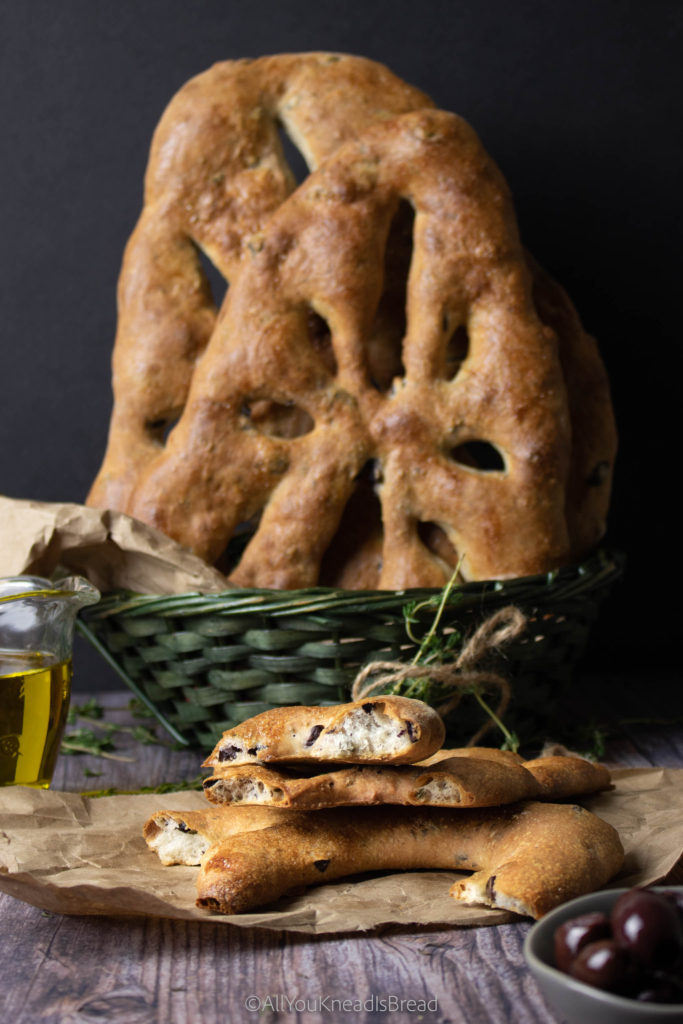
How to prepare this sourdough fougasse
As with any other sourdough bread, we need to start mixing the ingredients. If you know my baking style, you know that I add starter and salt all at the same time. And this case is no different. However, due to the nature of pasta madre, you probably can’t dissolve it in the water the same way you do with a liquid starter.
What I like to do is hold back about 20% of the water to start with a bit of stiffer dough, and then progressively add the rest of the water and finally the wet fillings. This is what works for me, but if you want to add all the water right away and just knead directly it’s fine too.
This is a lovely dough to work with, honestly. You can use your stand mixer but if you want to try doing it by hand, I think it’s a beautiful recipe to do so!
If you’re using a liquid starter just dissolve it in water and proceed with the rest of the ingredients. You don’t need to add water slowly.
When should I add the fillings?
I like to classify fillings into two groups: wet and dry. Wet fillings are those that carry a considerable amount of moisture with them and that could, potentially, alter the dough. These are things like olives, roasted peppers, capers… Dry are those that don’t carry with them much moisture like spices, herbs, cured cheese, dry things preserved in oil (sundried tomatoes, caramelized onion…).
Why this classification? When we need the dough we usually apply pressure to the ingredients that are in the dough. Wet ingredients will release that moisture if we “squeeze” them as we knead the dough. And our somehow stiff dough can become sticky in no time!
What I like to do is add the dry ingredients mixed with the flour and wait until the dough is developed to add the wet, then I just have to knead enough to incorporate the fillings, and not for incorporating them filings and developing the gluten at the same time.
For this sourdough fougasse, I used black olives and thyme. Thyme is not a problem, it’s a “dry” ingredient (even though I used fresh herbs, but you get the idea), you can add it at the beginning with the flour and the other ingredients. Olives, on the other hand, are preserved in brine, they carry quite an amount of moisture. So I added them at the very end. Once the dough was ready and the gluten was where I wanted it to be, I added the olives and kneaded just enough to incorporate them.
Don’t worry if by doing this you still have a couple of olives that aren’t incorporated, just put them on top of the dough, after they bake they’ll give your fougasse a rustic look!
How to ferment this sourdough fougasse
Since fougasse is a flatbread of sorts, it’s okay if the dough is not super strong. In other words, it’s okay if we over ferment it a little if that’s going to fit our schedule better. Here you have a couple of options:
Same day fougasse
Start the dough early in the morning, knead it well, add all the fillings, and let it ferment (bulk ferment) until it doubles in size and gets a bit puffy. Depending on your temperature, this might be anywhere between 3-5h. If you’re using a clear bowl you should see some fermentation bubbles in the bottom but nothing too crazy. Try not to over ferment it or when you want to shape it and cut the slits it’ll be tricky.
Then proceed to divide the dough into as many fougasses as you wish to make, shape them, and let them proof. We’re not looking for super chubby fougasses here. So when you start seeing them rising a bit turn the oven on and continue proofing while the oven preheats.
If you’re an early bird you might have them ready by lunchtime, if you’re a sleepyhead like me, maybe aim for dinner to be safe 🙂 *giggles as she writes this sentence*
Overnight fougasse
This method is based on cutting the bulk and keeping the dough in the fridge until you’re ready to continue. So, let’s say you refresh your pasta madre in the early evening or your stiff starter is not ready until later in the day. Maybe you don’t have time to bake your fougasse the same day. In this case, what you can do is prepare the dough and start the bulk fermentation. Then 1 and a half or two hours later put the bowl in the fridge and keep it there overnight. Then the next morning take the dough out of the fridge and divide it into the number of pieces you want. This way the dough will come to room temperature a bit faster
How to shape your sourdough fougasse
Either if you are following the same-day method or the overnight method. After dividing the pieces shape them into a ball, cover them with a cloth or plastic wrap, and let them rest for 20 minutes or so.
After the rest period is over… Unleash your inner creativity! The basics of shaping a fougasse are:
Flatten the piece of dough into an oval-ish/triangular-ish/leafy-ish shape, then cut slits with a bench scraper or a pizza cutter (bench scraper works better for me), loosen up the slits, and done!
Don’t try to make them perfect, the beauty of a good fougasse is in that rustic touch! I personally like a triangular/leafy kind of shape. I think they look really nice and if you have a bread basket they will look very cute in it. Also, feel free to use plenty of flour to avoid the dough from sticking to the counter. Cutting the slits can be tricky.
Baking your sourdough fougasse
Once you’re done shaping the fougasses, cover them and let them proof at room temperature until they start getting puffy, but didn’t necessarily grow much. At that moment turn your oven on at 425F/220C. The proofing stage will continue as the oven preheats. If you have an old metallic tray, put it in the bottom part oven, you will use it to create steam.
When the oven is ready put your fougasses in the middle part of the oven and throw a cup of boiling water into the bottom tray. This will create a nice touch of steam for the first few minutes.
After 10 minutes or so, you can retrieve the bottom tray and continue baking until your fougasses have a nice golden brown color. Let them cool down on a rack until you can hold them with your hands without burning yourself and enjoy!
A few tips about this sourdough fougasse recipe
For a shiny touch, I like to brush my fougasses with egg wash. This also allows the crust from drying out too quickly. This bread is pretty thin, so a bit of extra moisture is always helpful.
If you don’t want to brush your fougasses with egg wash, you can spray some water before putting them in the oven. This, along with the steam we create with the boiling water, it’ll be enough.
Fougasse is best consumed right away. When it’s crispy outside and soft inside. It’s even better when it’s still warm. This bread is thin, most of the moisture scapes as it bakes, so it goes stale faster than other types of sourdough bread.
Can I use other fillings?
Absolutely! You can use other flavor combinations that you like. I love fresh herbs combined with something extra savory or umami (like olives, blue cheese…). But I also love caramelized onions and nuts together. The sky is the limit here!
Do I really need steam to bake it?
You don’t need it, but I think it’ll be a good idea. I always get better results when I add steam during the first 10 minutes of baking. Since these are pretty thin, the crust will dry out quickly. A bit of steam will help to create a fluffy interior and crispy crust! But if you can’t create steam don’t worry, your fougasse will still turn out delicious!
How big should my fougasse be?
With this recipe, you can make one mega-fougasse, 2 large fougasses, 3 medium fougasses, 4 small ones, or 5 tiny ones. Just be careful when you bake them because the small ones will bake faster.
That is all for today! If you liked this recipe, you might also like these other ones, give them a try and let me know what you think!
Brie and olive sourdough rolls
Tomato and rosemary sourdough bread
Gorgonzola and apple sourdough bread
If you make any of my recipes let me know what you think! As always you can find me on Instagram, Pinterest, and Facebook. And I also have a few videos up on my Youtube channel (which I hope I can resume soon!)
Starting on breadmaking but don’t know where to start? Check my amazon store to see my favorite and affordable utensils you will need. No need to buy a $200+ baking pot. You can make the best bread with simple and affordable tools! (This is an affiliate link if you purchase something from this link I will make a small commission that helps me run this blog, but you will not be charged any extra money 😉 )
Happy Baking!

Sourdough Fougasse with pasta madre discards
Make this incredibly aromatic bread typical from the Provence using your pasta madre discards!
Ingredients
- 500 g bread flour
- 100-120 g pasta madre discards see notes
- 300-350 g water see notes
- 50 g extra virgin olive oil
- 8-10 g salt see notes
- 135 g sliced black olives drained and patted dry
- 10 g fresh thyme leaves chopped
- 1 egg for brushing optional
Instructions
-
Mix salt, chopped thyme, and flour in a bowl and set aside
-
Cut the pasta madre into smaller pieces and add them into the bowl that has the flour mix
-
Add about 80% of the water, the olive oil, and start kneading until you feel the pasta madre is incorporating well into the dough. Then add the rest of the water
-
Knead the dough until the gluten is almost developed and add the drained olives
-
Do a set of stretches & folds to help incorporate the olives. If the dough feels tight and you can't incorporate them, let the dough rest for 20 minutes to relax the gluten. Then proceed again to finish incorporating the olives
-
Once ready lightly oil your bowl and put the dough inside, let it proof at room temperature until it doubles or almost doubles and you see some fermentation bubbles at the bottom (Refer to the post to see how you can do a cold retard of this dough)
-
When the bulk fermentation is over, lightly flour your counter and divide the dough in as many fougasses as you want (3-4 pieces will have a nice medium-small size). Shape the pieces into dough balls, cover them and let them rest 10 minutes
-
Take one dough ball and flatten it with your fingers giving it an oval or semi triangular shape. With your fingertips stretch the dough into a larger piece of about 1cm/0.5in thickness. Use as much flour as needed to avoid the dough from sticking
-
Once you have shaped all pieces cover them and let them rest for 10 minutes
-
Place the pieces on the trays you will use to bake them and with the narrow side of a bench scraper cut slits into the fougasse pieces and stretch them a little so the cuts don't close while the dough proofs and bakes
-
Cover the fougasses and let them proof until you see them getting puffy, then turn on the oven at 425F/220C and finish proofing while the oven preheats. If you want to create some steam place an old metallic tray in the bottom part of the oven
-
When the oven is ready brush the pieces with egg wash for a shinier touch (optional) or just spray some water. Bake them for about 30 minutes or until they get a nice golden brown color. If you are creating steam in the oven you can add a cup of boiling water into the tray that has been preheating in the bottom of the oven.
Recipe Notes
*If you are adding wet fillings (like olives) start with the lesser amount of water, if the fillings are dry (like herbs or cheese), add the greater amount of water
*Use just 8g of salt if you’re using very salty/umami fillings like olives, anchovies… otherwise use 10g
How to make sourdough burger buns

It’s officially cookout season! And we bakers know that’s time for some homemade burger buns. Today I’m showing you how to make sourdough burger buns that don’t fall apart. Tired of your hamburgers buns going soggy and the fixings slipping away? With these sourdough burger buns, you won’t have that problem again!
These hamburger buns have a velvety crumb with a strong exterior to hold your fixings, but they will still melt in your mouth. These buns are designed to last through your last bite! You can also cut them in two and freeze them so you always have sourdough burger buns available for an impromptu hamburger.
Use a ripe sourdough starter
I’ve tried making this recipe with different sourdough starter ratios, at different temperatures, etc. One of the most important things in this recipe is the starter. Some recipes are more forgiving than others and you can get away with a bit of a lazy starter. But these burger buns require you to use your starter at its peak of activity. You can learn more about this in this blog post,
What flour should I use for these sourdough burger buns?
I used King Arthur bread flour with 12.7% of protein. If you have different flour, just keep in mind that the absorption will be different. If your flour has less protein, it will need less liquid to achieve the same consistency. And if your flour has more protein it’ll need more liquid to achieve the same consistency. This is important for you to be able to customize the recipe to your flour and kitchen conditions.
How to prepare the dough
It’s slightly sticky, so that’s why you also need to knead the dough very well. When the gluten is fully developed, the dough is strong enough to pull itself and not leave bits everywhere it touches (like your hands!). Keep in mind that my flour is pretty strong; although you can use low protein flour, you will probably need to reduce the liquids (start with 10-15% less).

Mix everything together minus the butter. Once the dough can form a ball and it is not a shaggy mess, incorporate the butter and keep kneading. If necessary, let the dough rest for a few minutes every now and then so you don’t push the gluten too far. The process shouldn’t take you more than 1h (At the end of the post you will find a baking schedule so you can plan ahead).
I know many recipes call for 3-5 minutes of kneading time, but that’s not even close to fully develop the gluten, especially in enriched dough. So, take your time, and let the dough guide you. The only way to get the best quality in your baked goods is by having a properly developed gluten. That gives the dough enough structure to get a nice fluffy crumb, and enough strength so it doesn’t collapse and you end up with super dense buns.
A note about fermentation
Once the dough passes the windowpane test, place it in a lightly oiled container and let it ferment until the next morning. You can always cut the bulk fermentation and keep the dough in the fridge once it’s doubled. In this case, I’d probably cut the bulk fermentation shorter to avoid the dough from over-proofing in the fridge.

How to shape these sourdough burger buns
Once the bulk fermentation is over, lightly flour your counter and carefully deflate the dough. Make sure you get rid of large air pockets in the dough and divide it into as many buns as you’d like. I like to divide into 8 for a medium-small bun, but if you want larger hamburgers, divide the dough into just 6 or even 4 buns.
PRO TIP: If you think the dough is too sticky and you need lots of flour, oil your counter and your hands instead. That way you avoid the dough from sticking and drying out!
Take one piece of dough and flatten it with your fingers. Then start bringing the edges towards the center to make it into a ball shape. Then turn it upside down so the seam is touching your counter and roll it with your hand to finish shaping the ball and create some tension on the surface. You can use a bit of flour to avoid the dough from sticking to your hand or even some oil.
Do the same with each piece of dough, cover them with floured plastic wrap and let them rest for 15 minutes.
After 15 minutes if you see they are very flat roll them again with your hand to shape them back into a ball. If after 20 minutes they look still plump then transfer them into your baking tray. I find it’s very easy when you use a bench scraper, just slide it under the rolls and carefully place them on the tray.
Cover the buns and let them rest for 2h or until they are puffy. They don’t necessarily need to double in size, but they should feel puffy and if you touch them, the dough should spring back slowly.

How to bake these sourdough burger buns
When you think the buns are almost ready, preheat your oven at 375F/ 190C. Once the oven is preheated, use the leftover egg whites to brush the buns. Then sprinkle sesame seeds and off to the oven!
Bake the buns until they have a nice golden-brown color, if your oven doesn’t bake homogenously turn the tray 180 degrees halfway in the bake.
Once the buns are ready transfer them to a cooling rack and let them cool down for at least 30 mins to 1h. If you try to cut them while they’re hot you will destroy the crumb, it’ll get mushy because although the buns are out of the oven, the crumb is still cooking.
In the meanwhile, you can prepare your fixings, the patties… And once the buns are ready cut them in two and enjoy your hamburgers!
PRO TIP: If you want your buns to grow taller rather than spread flat on the tray, you can use these English muffin rings. Put the buns on the tray, butter the rings, and put them around each bun while they proof and until they’re half baked. You can take the rings off when the buns start getting a light golden color. The result will be buns with the exact same shape and very plump. Perfect for a Big Mac copycat!
Baking schedule for a 74F/23C room temperature
If you’re planning hamburgers for lunch my suggested schedule for an environment of 74F is the following
The day before:
- 10 pm: Mix the ingredients and knead the dough
- 11 pm: Start bulk fermentation
The next morning
- 7 or 8 am: deflate and shape
- 7:15 or 8:15 am: Proof
- 10:45 am: Preheat your oven
- 11:15 am: Bake the buns
- 11:50 am: Take the buns out of the oven and cool down before consuming them
- 12:30 pm: Enjoy!!
I’ve tried this recipe on hotter and colder days. At 74F/ 23C it took about 9-10h to rise, at 68F/ 20C it took 11-12h. The dough should at least double or almost double before you divide it. Plan accordingly to your schedule and how early you’re willing to get up the next morning 😉
Do these burger buns have yeast?
No, they do not. They’re made with a 100% sourdough starter. However, if for whatever reason your starter is not ready, or you find yourself with a lot of sourdough discards. You can absolutely turn these buns into “sourdough discards hamburger buns”. Add the same amount of starter, and 5g of active dry yeast. The procedure is the same, only the fermentation times will vary. Instead of starting in the evening, you will have to start in the morning of the same day you’re planning to eat them.
But what if I want to make them using yeast?
If you don’t have sourdough, you can just substitute it with flour and water and use just yeast. If you wanted to replicate a sourdough recipe but using yeast you can prepare the dough using a very little amount of yeast (maybe 1g or even less), but yeast is still much faster than sourdough, so I cannot assure you the dough won’t overproof if you leave it all night fermenting. You might need to experiment a bit to find out a schedule that works for you.

Can I make dairy-free sourdough burger buns?
Absolutely yes! I’ve actually made this recipe with soy milk and plant-based butter and they were amazing too.
If you don’t use soy milk, try to use plant-based milk that has a thicker consistency and it’s a bit creamy. If it’s too watery you will probably need to reduce the amount of total liquid. You can also use no milk and make these with water, but again, be careful. It’s already a slightly sticky dough.
Can I make vegan sourdough burger buns?
Yes again! You just need to do a bit of math. A large egg is about 50g and 1/3 of the egg is the yolk. Egg white is more liquidy and the yolk has some fat. You can substitute 2/3 of an egg with water/plant-based milk, and the other third you can substitute it with some type of fat (vegan butter, olive oil…). This recipe for vegan Hokkaido milk bread can also be shaped into buns and used for hamburgers, although it uses yeast.
Let me know if you make these delicious sourdough burger buns and I hope this year we can start enjoying cookouts and bbq gatherings with friends and family. Don’t forget to tag me on Instagram and use #allyoukneadisbread so I can see what you bake!
If you want to see more bakes you can find me on Instagram, Facebook, and Pinterest, and you can also subscribe to my Youtube channel.
Happy baking!
This post contains affiliate links and any sales made through such links will reward me a small commission – at no extra cost for you – that allows me to keep running this blog.
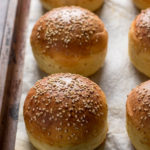
Perfect Sourdough Burges Buns
These sourdough hamburger buns have a velvety crumb and they melt in your mouth. Designed to last through your last bite!
Ingredients
- 355 g bread flour 12.7% protein
- 100 g active sourdough starter 100% hydration
- 40 g water
- 90 g milk
- 2 L eggs
- 1 L egg yolk
- 25 g sugar
- 8 g salt
- 50 g softened butter
- 1 tbsp sesame seeds (optional)
Instructions
-
Mix the eggs, yolk, water, milk, sugar, and starter in a large bowl (or stand mixer bowl)
-
Add the flour and salt to the wet ingredients and combine until you have a messy dough
-
Cover and let rest for 30 minutes (if your kitchen is too hot, let it rest in the fridge)
-
After 30 minutes start kneading the dough and once it becomes less sticky incorporate the butter
-
Continue kneading until the dough is very elastic and the gluten is properly developed. If necessary, let the dough rest for a few minutes once in a while
-
Shape the dough into a ball and place in a lightly oiled container until it doubles or almost doubles in size *See notes
-
When ready (if you followed my schedule, this step would be the next morning), carefully deflate the dough and divide in 8 equal pieces for medium-size buns, or 6 for larger buns
-
Shape each piece into a little ball and place them on your baking tray. For taller and exact shape buns you can use English muffins rings to proof and bake them
-
Cover the buns with lightly floured plastic wrap and let them rise until they're puffy and have grown in size (they don't necessarily need to double)
-
Preheat your oven a 375F/190C when the buns are almost ready (reduce the temperature a little if you have a convection oven)
-
Brush each bun with the leftover egg white and sprinkle with sesame seeds (optional)
-
Bake for 30-40 minutes or until the buns have a nice golden brown color. Time will vary depending on the oven **See notes
-
Once the buns are the color you like, remove them from the oven and let them cool down in a cooling rack. If you like them a bit more humid, let them cool down covered with a dry cotton cloth
Recipe Notes
* Please refer to the post for a baking schedule and approximate fermentation times
** If you used English muffin rings make sure to oil the inside, you can remove them when the buns are halfway baked
How to make Sourdough Marble Rye Bread
I think one of my favorite sandwiches during summertime is tuna salad on marble rye bread. And since the weather down here it’s starting to warm up, I decided to post my recipe and show you how I make my sourdough marble rye bread!
What is marble bread?
No, it’s not rock-hard bread, don’t worry! If you’re not familiar with marble bread, it’s basically a two (or more colors) bread that is shaped in a way that when you cut through it you can see a pattern. In this case, that pattern is a swirl with two colors, but other times the pattern is more abstract.
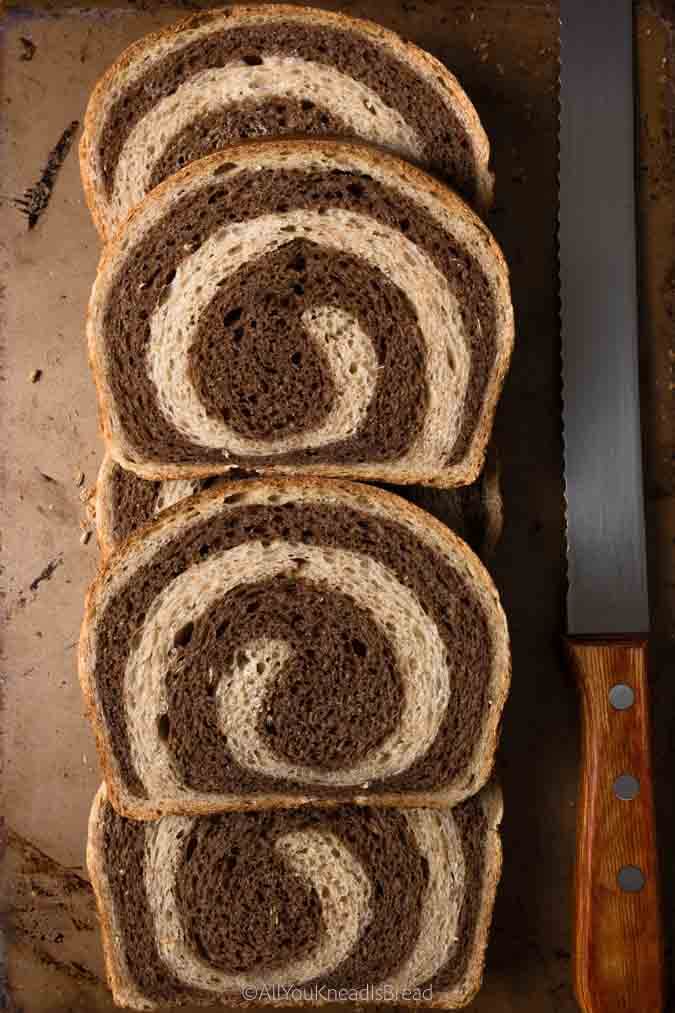
Best sourdough marble rye bread recipe
Okay, okay, maybe this is a bit of an overstatement, but I’m very happy with this recipe! I have tested different rye:wheat flour ratios and I think I have found a balance between both that gives you a great dough consistency and a loaf that is not dense at all while enjoying a nice rye flavor. You will make the best sourdough marble rye bread sandwich!
Of course, you can play around with these ratios. However, know that rye gluten behaves a tad differently and you might end up with a sticker dough. That’s not a problem, because this bread is baked in a tin, but when it comes to the marble part, you could end up with a wonky pattern.
I have tried to make this loaf a bit more accessible for those that can’t find some ingredients. Firstly, because there’s no need to spend money on a type of flour you’ll barely use. Secondly, because many of you might still have difficulty finding certain ingredients. So, don’t worry, you don’t need pumpernickel flour. However, feel free to substitute the rye flour in the dark dough for pumpernickel if you prefer.

Ingredients for this sourdough marble rye bread
For this recipe, I used this dark cocoa powder to color the dark dough because that’s what I usually buy. Feel free to use whichever cocoa powder you have access to (preferably unsweetened). Some people even use instant coffee, but in my opinion, I think cocoa powder does a better job than coffee bringing all the aromas and flavor together.
As far as the starter goes, I don’t have a rye sourdough starter. I used my white one for this dough and it worked great. If you have a rye starter, feel free to use it. Although, you can also build a levain with the flour mix. The most important thing is that the starter is active and by the time of use it has reached its peak of activity. You have all the information about it here.
I also used this whole rye flour and just sieved out large bran bits. I love this brand and I also LOVE the packaging. It has a velcro style sealing that really seals the bag! Much more convenient than the zip-style kind of seal!
If you use white rye, you will probably need less water. You can add maybe 80% of the water in the recipe and add more if necessary. The dough is a bit sticky but not messy sticky. I like whole rye flour because it adds another layer of flavor to the loaf and a bit of extra complexity that goes great with the caraway seeds.
When I buy spices I tend to buy in bulk because little containers annoy me. I always have large glass containers (pickle jars!) that I keep precisely to use with my spices. If you’re like me, then these seeds might be the ones for you! It’s a whole pound, but trust me when I tell you that you’ll be making this sourdough marble rye bread often!!
Can I use all purpose flour?
Absolutely! But since it has less protein content, you will need less water, so measure the water in the recipe, and then add it little by little until you think it’s enough. You might need as little as 70% of the water in this recipe.
Bulk fermentation
I did my bulk fermentation overnight because my house was a bit chilly (69F/20C), it took about 8-9h before I shaped the loaf. If your home is warmer, maybe it’s better to start in the morning and keep an eye on the dough. I also try a higher temperature (75F/24C) in one of the tests and the dough was ready in 4-6h.
How to shape your sourdough marble rye bread

At this point, both doughs should have finished the bulk fermentation. Carefully degas them, shape them into a ball and let them rest for 10 or 15 minutes covered.
The shaping consists of two layers of dough, the thinner you make these layers, the thinner will be the swirl inside, and vice versa. I like to have a layer of about half inch/1 centimeter thickness. This way the swirl is nice and visible, the layers don’t tear during baking and you end up with a beautiful marble rye bread!
I roll my loaf in a way that the light dough is outside, that way I can judge by the color of it, how the bread is doing, and if it’s ready or not. Depending on the flour you use etc, your dough might be on the stiff or sticky side, don’t worry, I got you!
How to shape stiffer dough
If your dough is a bit stiff, it will be easier for you to use a rolling pin. Dust your counter lightly with some flour and flatten the light dough a little. Then with a rolling pin shape the dough into a rectangle of about 9×17 in/22x40cm and set aside. The shorter side will be about the length of your baking pan. once the light dough has the desired shape, do the same with the dark one.
Brush the light dough with a little bit of water, just enough to make the surface sticky. Place the dark dough on top and try to align them very well. Ideally, the sizes should be very similar. Then starting from the short side, roll the dough into a log. Pinch the edges and seal the seam, and place it into your baking pan.
How to shape stickier dough
If your dough is too sticky, instead of dusting the counter with flour, use oil to avoid it from sticking and making a mess. And do the same with your hands. Then carefully, flatten the dough, and with your hands keep pressing and spreading the dough into a 9x17in/22x40cm rectangle. Lift the dough often (careful not to stretch it too much) to make sure it’s still not sticking. Start with the light dough and finish with the dark one, to avoid dark bits of dough sticking to the light one.
Once you have both rectangles, place the dark on top of the light one and press them together. Starting from the short side roll the dough into a log, pinch the edges and seal the seam, and place it into your baking pan
.
Proofing and baking your sourdough marble rye
It’s important you let the dough rise, at least, until the highest part (usually the middle) reaches the edges of your baking pan; preferably, until it’s half-inch/once centimeter above the edge of the pan. I also don’t like to bake pan loaves with steam; so, to get good oven spring, you need to start with a loaf that’s already tall, or the crust will form fast and prevent the loaf from rising more, or tearing the dough and end up with a not sandwich-friendly shape.
Bake the loaf in an oven preheated at 350F/175C until it’s golden brown. You can also stick a meat thermometer into the loaf and once it reads 204F/96C your sourdough marble rye bread is ready! Try to reach the center, because it’s the part that takes longer to cook. This is the thermometer I use for pretty much everything. It’s really fast and can hold the highest or lowest temperature. It even has a light!
For a shiny crust, you can brush the loaf with milk or egg wash before it goes into the oven!

How long does this sourdough marble rye bread keep?
Assuming that you don’t eat it in one day, you can keep the loaf in a ziplock bag or airtight container at room temperature for up to 4-5 days (depends on the temperature of your kitchen). You can keep it in the fridge for up to a week, but I’d recommend you toast it first. Usually, the texture of bread that’s been kept at old temperatures is not the best.
Let me know if you make this fantastic sourdough marble rye bread and your favorite sandwiches to make with it! If you do, use #allyoukneadisbread on Instagram, I’d love to see what you bake and what you experiment with!
You can find me on Instagram, Facebook, and Pinterest, and you can also subscribe to my Youtube channel.
Happy Baking!
This post contains affiliate links and any sales made through such links will reward me a small commission – at no extra cost for you – that allows me to keep running this blog.
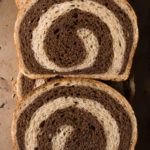
Sourdough Marble Rye Bread
Delicious and aromatic sourdough marble rye bread, perfect for sandwiches and toasts!
Ingredients
Light Dough
- 85 g rye flour
- 165 g bread flour
- 55 g mature sourdough starter
- 130 g water
- 5 g salt
- 15 g butter
- 10 g honey
- 1 tsp caraway seeds
Dark Dough
- 85 g rye flour
- 165 g bread flour
- 55 g mature sourdough starter
- 130 g water
- 5 g salt
- 15 g butter softened
- 10 g molasses
- ½ tsp cocoa powder (use dark cocoa powder for a darker color)
- 1 tsp caraway seeds
Instructions
Light Dough
-
Dissolve the sourdough starter in the water to break it down a little
-
Add all the other ingredients except the butter and mix them until you can't see dry flour particles. Cover and let it rest while you mix the dark dough
-
After a few minutes of rest start kneading the dough with your hands and incorporate the butter. Continue kneading until the dough is not sticky and is smooth
-
Lightly oil a container, place the dough inside, and let it ferment until is about twice the size (8-9h at 69F/20C or about 4-6h in a warm place, don't exceed 79F/26C) *See notes
Dark dough
-
Dissolve the cocoa powder in 50g of water until you don't have lumps
-
Dissolve the sourdough starter in the remaining 80g of water
-
Add the cocoa mixture and the rest of the ingredients, except for butter, to the dissolve sourdough. Mix the ingredients until you don't see dry flour particles. Cover and let it rest while you knead the light dough
-
Once the light dough is done and fermenting, start kneading the dark dough with your hands and incorporate the butter. Continue kneading until the dough is not sticky and is smooth
-
Once ready, lightly oil a container and place the dark dough inside to ferment (8-9h at 69F/20C or about 4-6h in a warmer place, don't exceed 79F/26C) *See notes
Shaping & Proofing
-
Once both doughs are ready, lightly flour your counter, and with a rolling pin roll both doughs separately to 1/2 in thick and as wide as your baking pan is. The thicker you roll the dough the thicker will be the spiral pattern inside, feel free to change the thickness to your taste.
-
Try to roll both doughs into a rectangle of similar size (Mine was about 9×17 in/22×40 cm). Once ready with a fork prick both doughs to make sure there aren't large air bubbles trapped between the layers later on.
-
Lightly brush the light dough with water (you can also use a spray bottle) and place the dark dough on top. You don't need too much water, just enough for both doughs to join together.
-
Carefully press both doughs with your hands to make sure there's contact everywhere and starting with the shorter side roll the dough into a log and pinch the edges together
-
Place the dough into a lightly oiled baking pan and cover it with plastic wrap, or a shower cap
-
Let the loaf ferment until the center is about the height of the pan or even a little bit more. The dough should feel puffy but still have good structure. My loaf at 73F took about 4h to rise **See notes
-
About 20 minutes before the dough is ready preheat the oven to 350F
-
When the dough is ready brush it with milk or egg wash (whichever you prefer) and bake for 35-45 minutes (until inside temperature reads at least 204F/96C)
-
Once the bread is ready take it out of the oven and let it cool down for 10 minutes before you take it out of the pan to finish cooling on a rack
Recipe Notes
* If your kitchen is cold and you need to leave the dough fermenting for a longer time, it’s better to do so during the bulk fermentation. I don’t recommend doing a cold-proof after the loave is shaped, it might not rise enough and end up under proofed. Also, do not use too warm temperature, as it could weaken the gluten network.
**It’s important you use a proper baking pan, otherwise, if it’s too wide, by the time the dough reaches that height it’ll be over-proofed.
Easy brie and olive sourdough rolls
Hello friends! Today I bring my new favorite recipe: brie and olive sourdough rolls! Brie cheese and black olives balance each other perfectly and combine great with the aromas of sourdough. These rolls are pillowy and delicate and can keep fresh for several days.

Brie, olives, and buckwheat flour
Let’s talk a little about brie. It is a French soft cheese made of cow milk. It has a considerable amount of fat, so it melts easily while the rolls are baking and helps soften the structure of the bread. As a result, these brie and olive sourdough rolls turn out unbelievably fluffy and full of flavor.
I like black olives because they’re not as tangy as green or kalamata, and I think the flavor goes great with cheese in general, but brie in particular; however, you can experiment with other types of olives and try other types of cheese if you don’t like or don’t have access to brie. Cheese with at least 25% fat content will work better because the key of these rolls is in the fat melting.

The trick is using a strong enough flour that will hold the dough and all fillings and slightly weaken the gluten with flour that doesn’t have gluten. In this case, I used King Arthur AP flour (it is strong for an all-purpose flour, it has 11.7% of protein), and buckwheat flour. This combination not only gets the gluten where I want it to be, but it also enhances the flavor of the bread so it doesn’t get lost in the cheese and olive aromas. I used this buckwheat flour but I have also tried this one and I liked the results as well.
If you don’t have buckwheat, you can use other flours that have less or none gluten (whole wheat, teff…). Just keep in mind that you might need to change the amount of water on the recipe and the result could be a bit different.
About the dough
This dough isn’t very hydrated, so when it comes to incorporate the olives and the brie you will need to let it rest and stretch it little by little. Make sure you pierce large air pockets that you might catch while stretching the dough. These sourdough rolls shouldn’t have a dramatic open crumb, you should aim for smaller air pockets and pillowy structure.
How to incorporate the brie and olives
An easy way to add the brie and olives is to stretch the dough, add the chunks of cheese and olives and then fold the dough and shape it into a ball. However, when we fold the dough we also trap a lot of air that will affect the structure of our crumb, and thus, the dough doesn’t feel like it has naturally incorporated the fillings. It’d feel like it has layers and the chunks of cheese or olives will come out of the dough easily.
To avoid this you just need to 1) Pierce large air pockets, 2) Knead the dough a little after adding the chunks and let it rest for 10-20 minutes, and 3) Knead again for a couple of minutes. Doing this will help you distribute the filling better and have an elastic dough.
This kneading is not meant to strengthen the gluten, but to help incorporate the ingredients. The gluten should be well developed before we add the fillings.
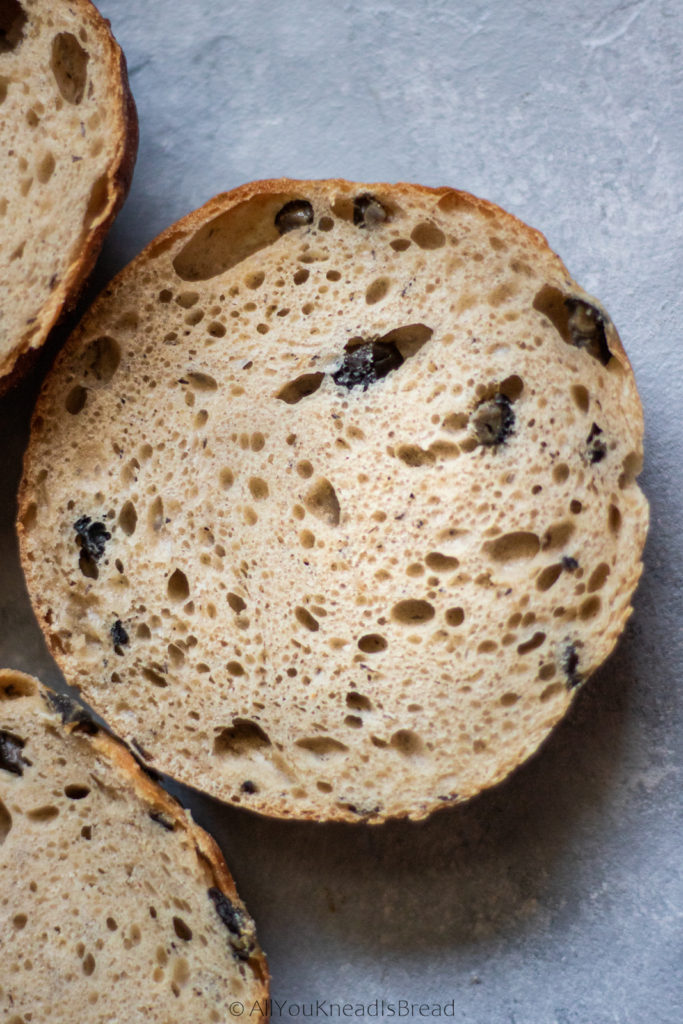
The fermentation
Sourdough always takes more time to ferment, but if you live in a pretty warm and humid place, pay attention to the dough. Let it ferment until you start seeing signs of fermentation (small bubbles in the bottom, feels puffy, has grown a little…), but don’t wait until it doubles or the gluten can be compromised and you’ll end up with a super sticky dough and flat rolls.
Once it’s clear that there’s activity, deflate the dough a little and put it in the fridge. It can stay there overnight.
Since you’re not going to proof the dough in a banneton, you can keep the dough in the fridge before shaping. Then, once shaped, you won’t need too much time before the rolls go into the oven!
Get your sourdough starter ready
Sourdough can be a bit tricky, but it all boils down to science! If you want to know more about the science of your sourdough starter, check this post where I explain all the phases your starter goes through and how you can apply that knowledge into your baking.
Knowing the science of your starter will help you adapt your baking schedule depending on the weather conditions. This summer is especially challenging here in North Carolina, but understanding the bacterial behavior helped a lot!
Final proof
The final proof is easy and somewhat fast. Take the dough out of the fridge, divide it into 8 equal pieces and shape them into small dough balls.
Let them proof in the tray you’ll use to bake them while you preheat the oven at 400F. No more than 1h should be fine if your starter is healthy and strong.
Before putting them int he oven score the surface of the rolls and off they go! In 20 minutes approx (depends on your oven), you’ll have these delicious brie and olive sourdough rolls!

How to create steam in the oven
Steam is very important when you bake bread, specially rustic style. When I bake loaves, I use my dutch oven and it usually is enough to allow the bread to open up. In this case, I use an old baking tray that I keep in the oven as it preheats, and when I load the rolls I add 1 cup of boiling water into that tray and immediately close the oven door.
Don’t open the door for the first 10 minutes of baking, some of the steam inevitably will scape but it’s better to minimize it.
Guaranteed deliciousness!
Since these sourdough rolls turn out so soft and airy you can use them to make sandwiches, sliders… And worry not! Because they won’t fall apart or crumble when you’re trying to take a bite or spreading butter on it😊
The rolls last fresh several days, but you can put them in a ziplock bag and freeze them once they’ve cooled down. You can keep them frozen for a few weeks.
If you decide to freeze de rolls, take them out of the freezer and let them chill for an hour or so, then bake them at 300F until they’re nice and hot inside. However, if you only need one or two rolls, why would turn the oven on? What I like to do in this case is slice the rolls before freezing them and when I want to make a sandwich, I just pop them in the toaster! It’s faster and your power bill will thank you 😉
Let me know if you make these rolls or any other recipe! I love to see what you bake and what you experiment with. You can use #allyoukneadisbread on Instagram.
You can find me on Instagram, Facebook, and Pinterest, and you can also subscribe to my Youtube channel.
Other sourdough recipes
If you’re looking for some sourdough inspiration check these other recipes:
Tomato and rosemary sourdough bread
Gorgonzola and apple sourdough bread (video included!)
Sourdough donuts with rose cream filling
Sourdough chocolate banana bread
Happy baking!
This post contains affiliate links and any sales made through such links will reward me a small commission – at no extra cost for you – that allows me to keep running this blog.
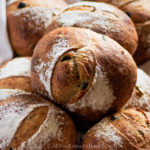
Easy brie and olive sourdough rolls
Fantastic sourdough rolls with a twist. Your new favorite!
Ingredients
- 385 g strong all purpose flour (11.7% protein)
- 65 g buckwheat flour (or similar)
- 70 g active sourdough starter
- 7 g salt
- 80 g black olives (sliced)
- 100 g brie cheese (with or without the rind and cut into 0.5 in/ 1 cm pieces)
- 270 g water (room temperature)
Instructions
-
Dissolve the starter in the water and add the flours and salt. Let it rest, covered, 20 minutes
-
Add the salt and start kneading. Knead until the dough feels elastic, it's smooth and doesn't stick to your fingers. If you need to let it rest a few minutes, do so.
-
After kneading, and once the dough is well developed, let it rest 30-60 minutes in a lightly oiled bowl
-
Oil you rcounter lightly, just enough so the dough doesn't stick and carefully try to stretch the dough on the counter into a 18×18 in / 45×45 cm square. It doesn't have to be exact.
-
Distribute the olives and cheese evenly and carefully fold the dough and shape it into a ball. Pierce large air pockets that might've been trapped during the process. Let the dough rest 20 minutes.
-
Knead the dough a little to make sure the filling is well distributed and has been incorporated into the dough (so they won't come out). If you find it easier do some stretch and folds do so. Just make sure the add-ons don't come out easily.
-
Let the dough ferment until it feels puffy, it has grown a little and you see obvious signs of fermentation. Mine, at 74F took about 4 hours. Then carefully deflate the dough and plut it in the fridge over night.
-
The next morning turn the oven on at 400F with an empty pan in the bottom rack. If you have a pizza stone, place it in the middle rack and preheat the oven for 30-60 minutes (depends on your oven, if you have a stone etc.)
-
While the oven preheats, divide the dough into 8 equal pieces and shape them into balls. You can do a pre-shape and final shape, but since they're not going to proof for long, you might not need to preshape them.
-
Place the rolls in the baking tray and once the oven is hot score them with a blade or sharp knife and put the baking tray in the middle rack (or on top of the hot stone if you have one). Add 1 cup of boiling water to the empty tray in the bottom rack and close the oven door immediately.
-
Bake the rolls with steam, for at least 10 minutes and another 10 minutes without steam or a few more minutes if they're not golden brown yet.
-
Let the rolls cool down for at least 30 minutes to allow the crumb to set, and dig in!
Tomato and rosemary sourdough bread

One of the most typical summer lazy dinners I used to grow with was “Pa amb tomàquet” (or commonly referred to as “pan tumaca”). It translates to “bread and tomato”. It is basically a toast with rubbed tomato and olive oil, I wanted to introduce my husband to this dish and that’s when I had an idea… What if… What if I add the tomato to the dough? And what if I add some other herbs? So I did… And that’s how this tomato and rosemary sourdough bread was born!
The result was amazing! This tomato and rosemary sourdough bread was so flavorful! The ingredients balanced each other perfectly and the loaf turned out super soft. The crumb was very soft and delicate.
Since the hydration is not too high, the dough is lovely to work with. If you’re feeling adventurous, it can be a great bread to practice your scoring!
Here’s the video of how I scored this loaf:
I used my wiremonkey bread lame that you can purchase here.
I love this lame, it’s ergonomic, efficient, easy to work with and allows you a range of movement that you don’t have with other lames. And best of all? It’s a family business that throughout the pandemic has been helping bakers in need. Not to mention that Tyler is also environmentally conscious and doesn’t use plastic on his lames.
If you’re into bread art or are looking for a nice bread lame, consider buying a wiremonkey ufo lame. They’re simply amazing!

The ingredients
For this recipe, I used Roma tomatoes because they are less watery, so if you’re using other types of tomatoes, I’d suggest you either reduce the amount of water on the recipe or drain the tomatoes a little.
I decided to make a paste first with all the ingredients so I blended the tomatoes, olive oil, salt, and rosemary leaves together. But if you prefer, you can leave the leaves out and add them whole.
Tomatoes and health
Did you know tomatoes are rich in lycopene? A red carotenoid that it’s known for its anti-cancer properties and powerful antioxidants. Tomatoes are also rich in potassium and magnesium. In other words, tomatoes rock!
Not only they’re healthy, but some studies have found that adding tomatoes to bread increased dough elasticity. That, along with the olive oil makes the dough LOVELY to work with, and it’s one of the reasons the crumb is so nice and velvety. Ahh Science! 🙂

How to make this tomato and rosemary sourdough bread
If you follow me on Instagram you might know by now that I’m leaning towards kneading my loaves rather than doing just stretch and folds. I don’t laminate my dough unless I’m going to add things to it (olives, nuts, cheese…). I don’t do long autolysis either, especially during summer because the higher temperatures really have an impact on dough strength.
What I do is mixing all the ingredients, I give them a 20-60 minutes rest (it depends on how busy I am or what I’m doing at the moment) and then I knead using the slap and fold method. I knead the dough for a few minutes and then let it rest for a little while. Resting periods are very important as you allow the gluten strands to realign and the dough gets stronger; you can read more about it here.
Kneading is just a way to 1) strengthen the gluten and 2) incorporate air in the dough. So, you can use whatever method you’re comfortable with. Manually or using a stand mixer, as long as you develop the gluten well.
Bulk fermentation
Once you’re sure the gluten is well developed, you can add a coil fold if you want. Then let the dough ferment for a few hours. The temperature in my kitchen ranges from 74-77F these days, so usually I don’t leave any dough out for longer than 6h (start to shaping). That’s why I also prefer kneading vs. not kneading. It allows me to develop the gluten faster and have a nice bulk fermentation in just a few hours.
I don’t wait until the dough doubles in size, I tend to cut the bulk fermentation short. With summer temperature and humidity under fermenting the dough a little helps maintain the gluten structure strong throughout the entire process.
The length of the bulk fermentation depends on how much starter you used, the temperature of your kitchen, the condition of your starter etc. If you want to know more about sourdough growth and sourdough starters click here. You can learn the science of sourdough and how that applies to your sourdough bread.
If you’re a bit new to sourdough and are not sure about what to do, you can check other things to make sure the fermentation is going well. For example, after a few hours of bulk fermenting: does the dough feel puffier? Can you see small bubbles forming in the bottom? Did the dough grow a little or can you even see some larger air pockets on the surface? Does it smell just like flour or can you identify some slightly alcoholic/vinegary smell (similar to the smell of your starter)?
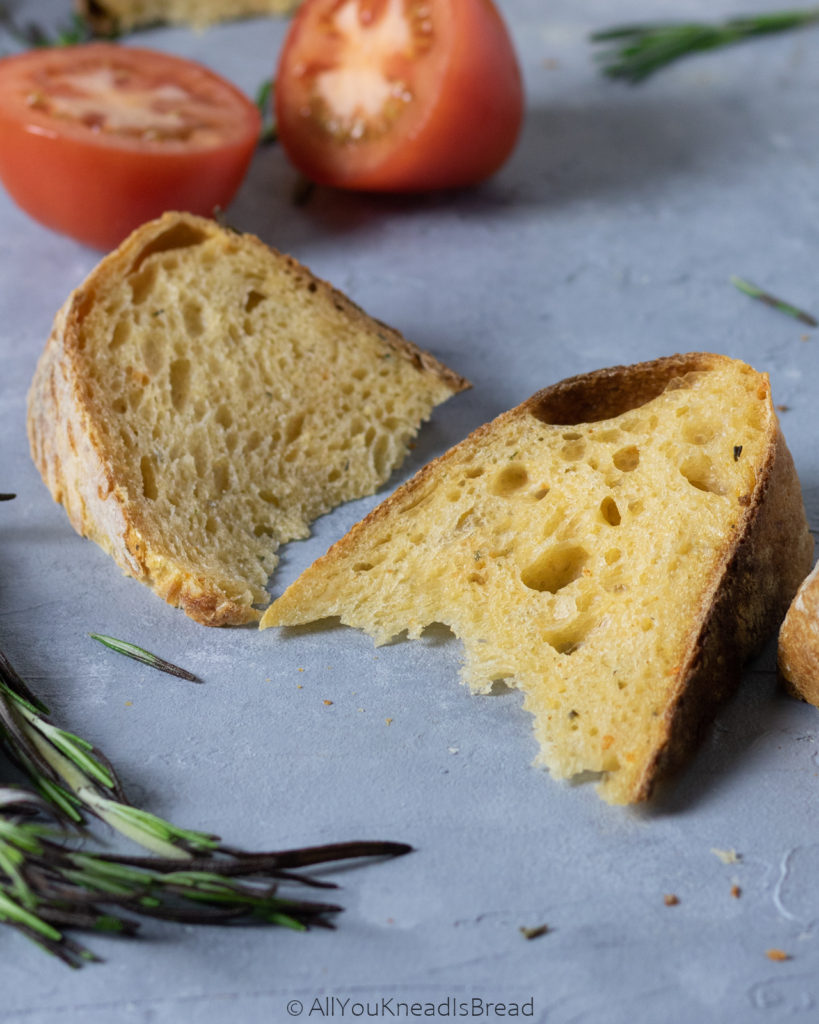
Shaping and cold proofing
Alright, so once you consider that the bulk fermentation is done, you just need to shape the bread and put it in a banneton (proofing basket). If you don’t have one, you can use a bowl and a cotton cloth.
I shaped this loaf into a bule, but you can use whichever shaping method you’re comfortable with. Be gentle, don’t push to much or you could tear the outer layer and the loaf will lose structure. If that happens, you might end up with a pancake after baking!
I have this round banneton, and I really like it. 9 in is enough for a medium-size loaf. I also have this oval banneton, I am very happy with both of them.
The overnight cold-proof was a total of 12h. A cold-proof is not mandatory, but it does come handy when it’s time to score the loaf. Colder loaves are firmer, and the blades cut through the dough much better.

Baking
Ideally, the first 15-20 minutes of baking should be with steam. In a house oven, keeping the steam inside is almost impossible, so I prefer to use a dutch oven that I preheat along with the oven at 450F.
I actually have a double dutch oven, I find that it’s much easier to load the dough without burning yourself if you can set the dutch oven upside down 😉
When I put the loaf in the dutch oven I also add the rosemary stalks. I’m telling you… the stalks end up roasted but the loaf is baked in those aromas and the crust ends up with a nice rosemary kick!.
After baking, try to wait for the bread to cool down to room temperature. It helps to set the crumb and all the aromas. Thanks to the tomato and the oil, the bread will be very soft, and it’ll keep fresh at least a couple of days.
Let me know if you make this loaf! I love to see what you bake and what you experiment with. You can use #allyoukneadisbread on Instagram.
You can find me on Instagram, Facebook, and Pinterest, and you can also subscribe to my Youtube channel.
Happy baking!!
This post contains affiliate links and any sales made through such links will reward me a small commission – at no extra cost for you – that allows me to keep running this blog.

Tomato and rosemary sourdough bread
An amazing bread, full of flavor and ideal for summer dinners!
Ingredients
- 300 g bread flour
- 150 g water
- 45 g sourdough starter at its peak of activity
- 75 g roma tomatoes
- 20 g extra virgin olive oil
- 6 g salt
- 2 stalks rosemary
Instructions
-
Blend the tomatoes, olive oil, salt, and the rosemary leaves together until you have a paste (you don't have to blend the rosemary leaves, you can add them whole or chopped to the dough)
-
In a bowl add the flour, make a well in the middle and add the water, the starter, and the tomato paste and combine until there aren't dry flour particles. Let the dough rest 20 minutes (covered)
-
Knead the dough until it's elastic and smooth. You can do it manually or with a stand mixer. I'd recommend you let the dough rest 10-20 mins every 5-10 minutes of kneading
-
When the dough feels smooth and elastic, lightly oil a bowl and place the dough inside to ferment. You can add a coil fold after 30-45mins if you want. At 74-77F (23-25C), my dough was ready after 5h.
-
Turn the dough onto a floured surface and carefully bring the edges toward the center to shape the dough into a ball, flip it upside down cleaning the flour underneath and with your hands, bring the dough ball toward you to create some tension on the outer layer
-
Flour a cotton cloth, place it in a proofing basket and put the dough inside. Cover it with the cloth and put the basket in the fridge overnight.
-
The next day, preheat your oven at 450F (230C) with a pizza stone or a dutch oven if you have , for at least 30-40 minutes
-
When the oven is ready, take your dough out of the fridge, flip it onto a parchment paper, put it in the dutch oven or the pizza stone and score the loaf (make some cuts on the surface). *SEE NOTES
-
Put the loaf in the oven and turn the temperature down to 425F / 220 C. Bake the loaf with a lid on (if you're using a dutch oven) or with steam (if you're using a pizza stone or just a baking tray) for 15-20 minutes. Remove the lid and bake the loaf for another 20-30 minutes or until it's golden brown
-
Take the dough out of the oven and let it cool down in a rack for at least 1h
Recipe Notes
* I like to put the dough on a thin metallic tray lined with parchment paper and then just slip it into the lid of my double dutch oven.
Easy and Delicious Sourdough Challah
Something good about this quarantine? It gave me the time I needed to create more recipes and do experiments with all my starters. I’ve had sourdough challah in my “to-bake” list for the longest time. And I finally have a recipe I’m 100% satisfied with.
I used all-purpose flour with a protein content of 11.7% for this delicious challah recipe. Don’t worry if you can’t find bread flour, I know it’s difficult to find these days.
UPDATE 10/18/2020: Based on the feedback I received, I decided to update this post to talk about the oil and how to easily incorporate it.

About the recipe
This dough is not on the sticky side, however, you need to make sure you develop the gluten very well. If you do so, you will have a delicate and cohesive sourdough challah that will stay fresh for several days. You can check this post for some guidance on how to knead enriched dough based on real bread science.
I can’t stress this enough: make sure you knead the dough well. Do it little by little. Allow the gluten enough rest if you think the dough is not really coming together after a while. If you’re using a stand mixer, the dough shouldn’t stick to the bottom. And if you’re using your hands, the dough shouldn’t stick to the heel of your hands or the counter.
Developing the gluten well takes a bit of time, but the reward will be amazing. You’ll end up with a dough that’s easier to handle (it won’t stick everywhere), a plump braid, and a bread that won’t dry out and harden right after it cools down.
The ingredients
Since this recipe doesn’t have a lot of moisture, I prefer to add all ingredients at once except the oil. I find it’s the best way to ensure salt and sugar dissolve well, and that all ingredients are properly distributed. You want to have a homogeneous dough.
Once you start kneading and the dough acquires certain consistency, add the oil and incorporate it well. This step might be easier to do by hand than with a stand mixer. You can add the oil little by little or all at once, whatever is more comfortable for you.
In the ingredient list, you’ll find a range in the amounts of oil and water. You can decide which type of dough you prefer. A slightly softer dough that leads to a slightly softer bread, or a slightly stiffer dough that’s easier to shape. The range is not large, but those extra 10 or 20g do make a difference, especially using AP flour.
My flour has 11.7% of protein, if yours has more/less, you will need to adjust the amount of water accordingly
What If I can’t eat eggs?
If you can’t eat eggs you can substitute them with pumpkin puree. It’ll give the dough an orangey color, but it’ll make the dough spongey too. Just be careful with the liquid because pumpkin puree does have some extra moisture.
How to incorporate the oil
If you have read some of my posts you know I’m very particular about developing the gluten network. Adding butter when the dough is half-developed is a bit of work but nothing impossible. However, adding oil can be a lot trickier. So here are my tips:
1) Add the oil little by little. If you add it all at once the outer layer of the dough will be covered in oil and won’t let it penetrate.
2) Squeeze the dough as you knead so you can break that outer layer and the oil can penetrate.
3) If you still have problems, cut the dough into smaller pieces to increase the surface area of dough that hasn’t been coated in oil yet (the inside part) and keep squeezing
4) If you work on your counter, squeeze the dough as if you were wringing out a cloth.
5) Be patient, it’ll take a few minutes but it’s not impossible!
The key to incorporate the oil is to make sure it can pass through that outer layer of dough that has been coated in oil and is slippery. You can cut the dough, squeeze it, wring it… Whatever works for you.
But.. Can I just add the oil with the rest of the wet ingredients?
Yes, you can AS LONG AS you make sure the gluten is developed correctly. The reason I encourage you to add it later is that we tend to stop working the dough absorbs the fats. And that leads to denser crumbs and lower quality bread.
But if you make sure you get that beautiful windowpane and a dough that is elastic and nice. Then yes, you can add the oil earlier in the process.
I’d still suggest you add it after mixing everything else, while you have that shaggy mess of dough at the beginning. The reason why is because the flour had at least some time to hydrate without oil getting in the middle. Moreover, the gluten network is still at a very early stage, so it’ll be easier to squeeze the dough and allow the oil to be absorbed.
How to ferment sourdough challah
I found that the temperature range in my house did not affect the fermentation too much. However, the amount of water did. Keep in mind that the temperature didn’t vary that much (68-74F) and wasn’t too warm.
Note: if your house is very warm, the temperature will affect the fermentation more than it affected me. Keep an eye on your dough during bulk fermentation.
While all sourdough challahs turned out great; I found that the recipe with a little more water fermented faster and the dough was a bit slacker; which made the braiding a bit more difficult as the ropes stretched very easily. The dough with slightly less water and oil ended up in very plump braids; (the very first photo), but the bread was slightly drier than I prefer.

I did all bulk fermentations overnight at room temperature (about 8h at 68-74F depending on the day). The recipe with more water over-proofed a little and developed a slightly sour taste (at both temperatures, even at 68F). However, you can fix this easily by reducing the bulk fermentation.
The recipe with less water didn’t get to rise that much but was still puffy and the taste was sweeter. After shaping, all loaves proofed for 3-4 h (until they were puffy, not until they doubled). The loaves with less water held the shape better.
You should take these experiments as a guide. But what you’re looking for is a puffy dough that still feels stiff (not sticky). If you press carefully, you should leave a mark that springs back slowly. You can adapt the fermentation to your own kitchen conditions.
What I’d suggest is to not rush the bulk fermentation. If your dough didn’t ferment enough, then it could tear open during baking.
Find the balance between temperature and fermentation
In any case, try not to over ferment the dough, or it might turn sour and slacker. It should feel puffy, it should smell like sourdough but not too acidic with slightly but pleasant acetic hints. Same for the final proof, let it get puffy but don’t wait until it doubles.
It’s very difficult to see when it doubles unless the dough is in a container. Waiting for it to double might end up in an over-fermented dough that will flatten during or after baking and won’t taste as nice.
How to braid this sourdough challah
Divide the dough into as many portions as you want strands in your braid. Let them rest 10 minutes before you make the ropes.
To make the ropes, flatten the dough balls into a 2 in/10 cm oval. Then starting on the long side roll the oval onto itself giving it some tension as you go. Once you shaped the log seal the seam.
Let the logs rest a few minutes; then starting from the middle towards the outside stretch the logs and make the ropes. If the ropes keep shrinking let them rest. The gluten it’s pulling and if you continue to stretch the dough you’ll end up breaking the gluten structure.
Braiding the challah a little loose will allow it to tighten as it proofs. It will puff up during baking and be very plump. If the braid is too tight from the beginning, it could tear during baking
After you brush your challah with the egg white, you can sprinkle some poppy or sesame seeds to decorate it!
Here you have a video for an 8 strand challah:
The good thing about challah dough is its versatility when it comes to shapes and braiding. If you’re looking for a beautiful shape but are a bit intimidated by braids, I’d suggest you try your hand at a round challah. It’s very easy to braid and you won’t get lost.
The baking
Since every oven is a bit different, bake your challah until it’s golden brown. If it gets too dark on top you can tent it with aluminum foil until it’s done inside. If you have trouble knowing if the bread is done, check the inside temperature. It should register at least 200F / 94C.
I have this thermometer and I’m very happy with it. It’s fast and accurate and it can hold the max/min temperature. What I like the most is that it has a magnet! So I can leave it stuck on the fridge while I’m baking for easy use.
After baking let the challah cool down for a while. It will help set the crumb and aromas!
I hope you enjoy this wonderful sourdough challah!
If you make this easy sourdough challah, let me know what you think and tag me on your creations! I love to see what you guys make!
You can find me on Instagram or Facebook and you can also subscribe to my Youtube channel.
For suggestions or want me to adapt a yeast-based recipe into a sourdough one, etc. please contact me and I’ll try my best to respond and plan a recipe!
Happy baking!
This post contains affiliate links and any sales made through such links will reward me a small commission – at no extra cost for you – that allows me to keep running this blog.
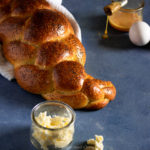
Easy and Delicious Sourdough Challah
A delicious sourdough challah with a very fluffly crumb. Perfect to eat plain, to make toasts, or even french toasts.
Ingredients
- 345 g king arthur all purpose flour (11.7% protein content)
- 110 g sourdough starter at its peak of activity
- 70-80 g water room temperature
- 1 Large egg
- 1 Large yolk (save the white for final egg wash)
- 50 g granulated sugar
- 80-90 g vegetable oil
- 6 g salt
- 1 tsp poppy or sesame seeds optional
Instructions
-
Add the water and the sourdough starter to a bowl and with a whisk bread down the starter
-
Add the egg, the yolk, and the sugar and combine everything
-
Sift the flour and salt together and add them to the dry ingredients
-
Combine everything until you don't see dry flour particles and let it rest 30-60 mins
-
Start kneading, if using a stand mixer you can use the paddle attachment
-
When the dough starts developing the gluten add the oil and keep kneading until it's completely absorbed (see notes)
-
Knead 4-5 minutes and let it rest another 5-7 minutes. Continue doing thes until it's ready (Let the dough rest as much as necessary).
-
When the dough passes the windowpane test and it's smooth and elastic, put it in a lightly oiled container and let it ferment until it doubles or almost doubles and feels puffy (at 68-74F it takes tops 8h, typically overnight)
-
Degas the dough and let it rest a few minutes. Then divide it in as many strands as you want for your braid, shape them into dough balls and let them rest (covered) for 10 minutes
-
Take one piece of dough and with the heel of your hand flatten it. Use a rolling pin to roll the dough into a 7 x 4 inches oval. Starting from the longe side roll the dough into itself and form a log. Pinch the seam closed and gently roll from the center outwards lengthening the log
-
Repeat with all the dough pieces, if it's difficult to stretch the log, let it rest a few minutes
-
Braid the challah and place it on a piece of parchemnt paper on the tray you'll use to bake it. Cover it with plastic wrap and let it rise until it feels puffy (at 68-74F it takes about 3-4h)
-
Preheat the oven for 20 minutes at 350 F. When the challah is ready, brush it with the egg white and sprinkle poppy or sesame seeds. Bake it for 35-40 minutes or until it has a nice golden brown color
-
Let the challah cool down to room temperature before slicing it
Recipe Notes
- If you’re kneading with a stand mixer you might find it easier to incorporate the oil by hand. Squeezing and twisting the dough will work faster.
- If you think the challah getting too dark but the inside is not done, tent it with a piece of aluminum foil.
- Kept it in a plastic bag or airtight container, it can last fresh and soft several days.
Gorgonzola and apple sourdough bread – Video

Hello friends!
I’ve decided that it was about time for me to post some sourdough bread recipe and spread the sourdough fever!
Before I start I’d like to make something clear:
There isn’t just one single method to make sourdough. Any bread, really. But especially sourdough. My method works for me because I’ve adapted it to my kitchen conditions, my flour, and our taste buds.
If you’re new to sourdough baking take this recipe as a guide and experiment with what you like
Since sourdough is the result of wild yeasts and bacteria fermentation, it’s unique for each person. Each starter is different because the flours used are different, the water quality is different, the temperature in each person’s kitchen is different…
Sourdough for beginners: what I wished someone told me when I first started
My very first sourdough bread was… pretty messy! I was intimidated and I thought that not following the recipe by the minute was going to turn my bread into something awful “OMG! It has fermented 5h and 1 minute!” So here are some of the things that I learned along the way:
1. Don’t worry! You can adapt the fermentation time to your own schedule. Sometimes deciding what you’re going to do with the bread is more difficult than actually making the bread. The more you bake, the more you learn.
2. Experiment, try different things. Shorter bulk fermentation, longer cold-proof… whatever works for you!
3. Flour flour flour! Flour your banneton, flour your dough and flour everything so the dough doesn’t stick to the banneton or the cloth. Too much flour ain’t never enough flour! After all the work you don’t want the dough to stick to the banneton or the cloth right before baking. Some people like to use rice flour or starch because they absorb more water and the dough never sticks. I found that all-purpose flour works great, as long as you use enough.
4. If anything, it’s better to under-ferment than over-ferment. Why? Scientifically speaking, the gluten network of over fermented dough loses strength and it’ll be difficult to shape, it won’t hold the shape during baking, and it’ll have a terrible oven spring because the lack of strength means less ability to hold gas inside (it’s the same concept as to over-knead the dough). Also, and this is my opinion, some people might disagree, but it’s been helpful for me: slightly under fermented dough has more chances to turn into a great bread than over fermented dough. The crumb might not have super large holes, or maybe you don’t have that tart taste you’re looking for, but the dough will hold the shape better, the oven spring will be better, and overall the bread will be better than an over-proofed one.
5. Make sure the gluten is developed. Either if you knead the dough by hand, on a stand mixer or if you do a “no-knead” bread. The dough has to be elastic and smooth, it shouldn’t be sticking everywhere. If you are kneading, there shouldn’t be dough on the walls of the stand mixer bowl, or on the counter. The dough has to be strong enough to be able to pull itself together without breaking. If you’re making “no-knead” bread, you should be able to stretch the dough without it tearing apart.
6. Shape the loaf well, don’t be afraid. During shaping, you’re going to use that strong gluten network that you’ve built to be able to create surface tension. That means that you’re going to stretch the outer layer of gluten in a way that will help keep the shape tight and in place, but if you push too much, the layer will eventually tear apart, and the bread won’t hold the shape. I like to think about it as covering a bowl with plastic wrap, you need the wrap tight in order to be in place, but if you pull too much, you will tear it.
7. Don’t get overwhelmed by information. The Internet is packed with sourdough recipes, methods, how to build a starter… My advice? Pick one method to build your starter and stick to it until you’re comfortable enough. Each method will be different and will be adapted to each baker. That’s why they’re all so different and why I don’t want to add more information about it, there’s just too much out there. If you really want to know how I built my starter, how I care for it etc. feel free to contact me and I’ll be more than happy to help!
8. BE PATIENT. Bread making is all about patience. If your first bread doesn’t turn out great, don’t worry! Keep trying. Write down what works, and what doesn’t. And if you want to experiment, change only 1 or 2 things at a time so it’ll be easier for you to narrow down what went wrong, what worked, what’s creating problems…
Let’s get to the recipe!
Gorgonzola cheese has a very intense flavor, it should be consumed in small amounts, so your palate is not overwhelmed and you get to enjoy all the aromas and flavors.
Apple is a sweet fruit but not too sweet that would take over the cheese taste. Actually, it helps your taste buds to balance everything every flavor.
And the bread, of course… the sourdough taste, the airy crumb, the slightly crunchy crust…

Are you drooling yet? I thought so 😊
I used 100g of gorgonzola (half packet) and 1 medium-large fuji apple. You can go for a tarter apple or a sweeter one.
I’ve tried this recipe with different water contents and the bread has always turned out very similar. The cheese fat and the water in the apple are essential to get the super soft bread. And because of those, the crust is crunchy but thin, so it’s not hard at all.
You’ll see how light and springy this bread is!

This bread is just amazing! I never recommend to eat the bread warm, but for this one? I can’t tell you to wait until it’s cooled down. Just give it 30 mins to set the crumb and go ahead! And since it has both savory and sweet, you can combine it with anything you want!
If you make this bread make sure you tag me on Instagram! I’d love to see what you made!
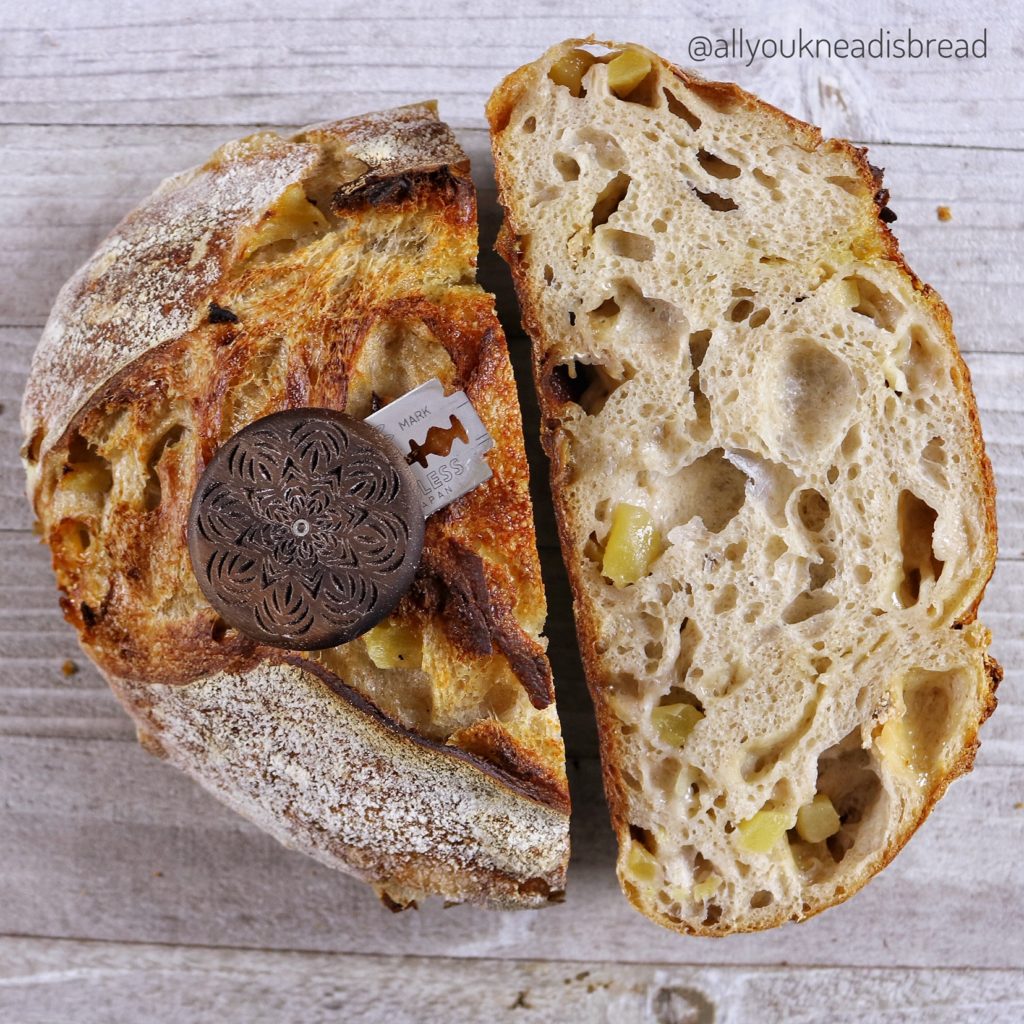

Gorgonzola & apple sourdough bread
This bread is very soft with incredibly balanced aromas
Ingredients
- 320 g bread flour
- 80 g whole wheat flour
- 320 g room temperature water
- 80 g 100% hydration starter
- 1 medium fuji apple
- 120 g gorgonzola cheese
- 7 g salt
Instructions
-
Mix flours and water (you can add less water if an 80% hydration is too much for you). Let the dough rest for up to 3h (autolysis)
-
Add the salt and mix the dough until you don’t feel salt particles. Wait 30 minutes
-
Add the starter, incorporate it very well and let the dough rest for 30-45 minutes
-
Peel and chop the apple and cut the cheese into small cubes
-
Laminate the dough: use your fingers and stretch the dough from the center towards the outside, don’t worry about the shape. Add the apple and the cheese and distribute them well. Fold the dough and shape it into a ball and place it back in the bowl. Wait for 45 mins
-
Do three sets of coil folds or stretch and folds every 45 mins (time can vary between 30-60mins). After the last set of fold, let the dough ferment until it doubles in size, the time depends on the temperature of the dough and the temperature of your kitchen (it can be anywhere from 3-8h)
-
Flour the counter well, let the dough fall from the bowl onto the counter by itself and shape it into a batard or a boule
-
Line a banneton with a clean cotton cloth and flour it generously. Place the dough into the banneton with the seam up and stitch the seam. Cover the dough with the cloth and put it in the fridge for 8-24h (If you don't have a banneton you can use a bowl).
-
Preheat your oven at 450F with a dutch oven inside (or a pizza stone or a baking tray) for at least 30-40 minutes
-
Take the dough out of the fridge and place it on a piece of parchment paper. Score the dough with a sharp knife or blade. Put it in the dutch oven and reduce the oven temperature to 425F . **See notes
-
Bake 20 mins with the lid on and another 15-25 mins without the lid or until it has browned nicely (depending on your oven the bread might be done earlier or later)
-
Cool on a cooling rack for 30 mins to let the crumb set and enjoy!
Recipe Notes
** If you don’t have a dutch oven, place another baking tray in the bottom rack while the oven it’s preheating. Add a cup of boiling water to that baking tray right after you put the bread inside and close the oven door fast. After 20 minutes remove that tray and bake the bread for another 20-25 minutes. If you use a pizza stone, be careful to not add the boiling water on it or it’ll, most likely, break.
How to create Lievito Madre (Pasta Madre) for panettone
UPDATE: This post has been updated to add some modifications to the process of creating your own lievito madre or pasta madre. The new information will be in colored boxes like this paragraph.
Hello everyone!
As promised, here’s my guide to building a lievito madre or pasta madre to make panettone. I will use both names because it came to my attention that some people are using the term lievito madre to refer to liquid sourdough and it’s not the same. I want you to get familiar with both names so you know that lievito madre or pasta madre are the same thing 🙂
First of all, I want to say that all this is not my idea. I’ve been reading blogs and watching videos to have a better understanding of the whole process. Eva’s posts were full of information. I’ve been tracking down everything the Italian Pasticcieri had online and read scientific publications to understand better how bacterias work (surprisingly there’s not much research on this).
This guide is a summary of everything I’ve read and everything I’ve learned every day, and I hope it can be useful to you. It’s focused on building and training the lievito madre. The next step will be the 3 refreshments before making panettone, which I will write about once I’m more familiar with the process.
For a better understanding of how sourdough bacteria grow, I recommend you read this post first. It’ll help you understand how pasta madre works.
When I first heard about panettone, I never thought it was this incredibly challenging bread! It never even occurred to me that it was made with sourdough or how laborious the process was!
To be honest, I do have a panettone recipe here, and trust me when I tell you that I spent a lot of time trying to get the dough right, but now… I feel like I was cheating! (I still think it’s a good place to start getting familiar with very enriched dough and gluten development).
A few notes about pasta madre
First and foremost, is not just a firm sourdough starter. This stiff dough is indeed a sourdough starter, but a special one. It requires a very specific maintenance routine and it has a very specific purpose: to bake grandi lievitati products such as panettone, pandoro, colomba…
If you want to make some rustic Italian bread using sourdough, you can create a stiff starter, or use your own sourdough starter. You wouldn’t need lievito madre, because you wouldn’t need the specific characteristics of grandi lievitati products in a rustic loaf.
Grandi lievitati bakes also require very strong flour, and most likely, your regular bread flour won’t be enough. Also, I wouldn’t say that nobody uses whole wheat flour, but I believe that’s not the most common way to maintain pasta madre.
Things you need to know before you start
These are things that I’ve learned along the way and that I think everyone should know before making the decision to start this journey.
- Be aware that it’s going to take 15 days to get the lievito madre ready. There are two major parts in this process: building the stiff starter and training it.
- I encourage you to do a few experiments to see if you can find a place where you can keep a constant temperature of 30C/86F. This step is crucial in the first couple of days and also to ferment the panettone dough.
- Check your schedule and plan accordingly. Don’t start making the starter on a Saturday at 1 pm if you won’t be home at 1 pm during the week because the cycles are either of 12 or 24h.
- Gather all your ingredients before you start and make sure you have enough flour. You will need it. I bought 15lb and it’s enough to prepare the pasta madre, train it and make at least 1 batch of panettone (probably more).
- If the quality of your water is not good, buy water (you don’t need a high mineral concentration in the water). If the quality is fine, I suggest you filter the tap water.
- Get your mind in the right place. Some days you will be tired and will want to go to bed, but you’ll have to feed your pasta madre, this is very important when you’re training it. The whole point of this is to reduce the acidity. Once is matured, you can put it in the fridge and feed it once a week.
- Be patient. Use your eyes and, especially, your nose to let the dough tell you what’s happening.
The process of creating your lievito madre
| Building period | |
| Day 1 | Make apple yeast water |
| Day 2 | Create a 100% hydration sourdough |
| Day 3 | Convert into a stiff starter and start anaerobic fermentation (wrapped log) |
| Day 4 | Wait. Nothing to do |
| Day 5 | Collect the core of the log, refresh it with flour and water and start fermentation in water |
| Training Period | |
| Days 6-10 | Refreshments using same amounts of flour and starter +30-50% of the weight of flour in water |
Building the lievito madre: 5 days
The first step of the building period is to activate the wild microorganisms found on apples. In other words: create an apple yeast water.
As you know, vegetables, fruits, cereals, etc have lactic acid bacteria and yeasts that are dormant and need to be activated.
These microorganisms, in general, proliferate better when their environment is moist. In science, we refer to this as “water activity”. This number ranges between 0 and 1 (pure water being 1), so the higher the water activity, the easier it will be for the microorganisms to wake up and grow.
Temperature is also crucial. Fermentation can occur at different temperatures, but not all microorganisms are activated at the same temperature. For panettone purposes, we should make sure our culture is at 28-30C (82-86F) so we promote the fermentation of specific strains of lactic acid bacteria.
A typical sourdough culture can have dozens of different strains of bacteria and many different types of yeast. So we can select which ones we prefer by controlling the temperature, moisture content, pH…
Day 1: Start the apple yeast water
You will need:
- 1 or 2 pesticide-free and untreated apples (I bought organic and they worked great, they shouldn’t have wax or anything, the more natural the better. If you can go to an orchard even better!)
- A glass container with a lid
- A grater
- Water at 30C/86F ( I used tap water filtered with my Brita)
- A scale
- A knife
- A thermometer
- A warm place where you can maintain a temperature between 28-30C/82-86F (my oven with the light on is enough, if it’s too cold and the temperature drops in the evening I put a glass with hot water on the other corner of the oven before I go to bed or when I wake up)
- Cut the apples in 4 and remove the core. You don’t need to clean the apples because if you do, you’ll probably wash out lots of nice microorganism. If there’s dirt on the stem area, just cut that part out.
- Grate the apples and keep the peels
- Weight 200g of grated apples and peels an place them in the glass container
- Weight 200g of water at 30C/86F
- Add the water to the glass container and close it tightly. You can shake it a little bit if you want
- Place the container in your oven or fermenter and wait for 24h
That’s it for now!
Day 2: create a sourdough starter with the apple yeast water
After 24h you might see small bubbles in your container, it can make a fizzy noise when you open it, it can smell like cider or maybe you can’t tell if something happened in there. That’s why this step is important. If after 24h, your starter doesn’t show activity, start with the apples again because something went wrong.
You will need:
- Fermented apple mixture from day 1
- A strainer
- A tall and transparent container*
- A spatula or a spoon
- 200g of Manitoba flour
- A scale
- Sharpie or rubber band to mark the container
Today is an easy day, enjoy it, because things get more complicated!
- Strain the apple mixture from the day before and collect the liquid. In my case, I didn’t see small bubbles, but it did smell like cider.
- In a medium bowl weigh 200 g of Manitoba flour and add 200 g of the fermented apple water. With a spatula mix well until you don’t see dry flour particles. It should look like a regular 100% hydration starter.
- Carefully transfer the starter to the tall container. And let it ferment at 30C for 24h. I put it in the oven with the light on. After 24h the starter will raise and collapse. At the very least it should double in size. That’s why it’s important to not leave dough stuck on the container wall because while the starter rises and collapses it’ll leave a mark on it, so you’ll be able to tell how far it rose. If there was anything there before, you might get confused.
NOTES:
You don’t have to put a lid on the container, you just need to place a napkin on top it there is any risk of something falling inside.
If you have it in the oven, try not to open the door all the time. That way you avoid streams of colder air coming inside and changing the temperature. The more constant the temperature the better. I checked my oven before going to bed and in the morning if the temperature changed too much overnight or I felt the house very cold.
Make sure the container you use for this is tall enough that can hold the dough even if it quadruples in size. Also, just in case some starter overflows, put a plate or a tray underneath.
*my container is a coffee canister that I bought in Walmart for less than $2. It’s 10x9x20 cm (4×3.6×8 in)
Day 3: Convert the starter into a stiff starter and do an anaerobic fermentation
Today is when you should start seeing activity in the sourdough. After 24h at 30C, your sourdough should’ve grown and collapsed. There should be some debris on the walls of your container that indicates how high the starter rose. It should’ve, at the very least, doubled in size. If it didn’t, at least, double, I’d start again. There aren’t enough bacteria or the ones that are in the culture, are not strong enough.
You must always keep in mind that making panettone is a difficult task and fermenting all that dough full of sugar, butter and egg is difficult too. So, we need to make sure that the bacteria we select and will train is the strongest.
The starter should be very runny, the same as a 100% hydration starter that has reached the peak and collapsed. It should have small bubbles on the surface and a pungent aroma. Don’t freak out if it smells like something rotten, so far, it’s normal. The bacterial colonies are fighting against each other, everything we do is to promote the survival of the ones we want.
The second time I built my LM I didn’t wait until it completely collapsed (24h), instead, I decided to proceed with the next step after 12h. This way most of the bacteria were still in the stationary phase, which means that I collected more live bacteria. Ultimately, my PM was more active than the previous one.
You will need
- 200 g of yesterday’s starter
- 200 g of flour (more if needed to achieve desired consistency)
- A rolling pin
- A scale
- A Ziplock bag
- 2 cotton cloths
- 1 meter/1 yard of some strong rope or string
- Collect 200g of the starter and add 200 g of flour.
- With your hands mix everything well. The dough should be dry and relatively hard, it shouldn’t stick to the counter but should be soft enough to work with a rolling pin. It is OK if you need to let it rest a few times to relax the gluten.
- Once you’ve incorporated the flour, with a rolling pin start working the dough until it gets a little bit more elastic. It doesn’t have to be extremely soft and smooth, but it shouldn’t have lots dry flour or chunks of dry flour either.
- Shape the dough into a rectangle-ish that’s about 20cm long and 15cm wide and roll it into a log. Place it into the ziplock bag and wrap it well. Wrap the packet with a cotton cloth and then with another cotton cloth and tie it with the rope or strings you have. It doesn’t need to be too tight, just enough to keep the cloths in place.
- Put the dough in an empty pot and put the pot inside of your oven (this is precaution, it can explode due to the built-in pressure). You don’t need to leave the light on. Just make sure that nobody turns the oven on and burn your pasta madre.
- Let it ferment for 48h. As time goes by the log gets harder and harder. That’s a good sign. It means that it is fermenting and as a result, the pressure is increasing.

Day 4: No need to do anything
Day 5: Collect the fermented stiff starter and begin the fermentation in water
After 48h the log might not feel as tight as after 24 or it might still feel a bit tight. Anyhow, today we’re going to unwrap the whole packet. Be careful because it can explode. Most likely, you’ll see how, due to the pressure built inside, the dough tore apart the plastic bag and some of it came out and it’s dry and stuck on the cloth. Don’t worry, it’s absolutely normal.
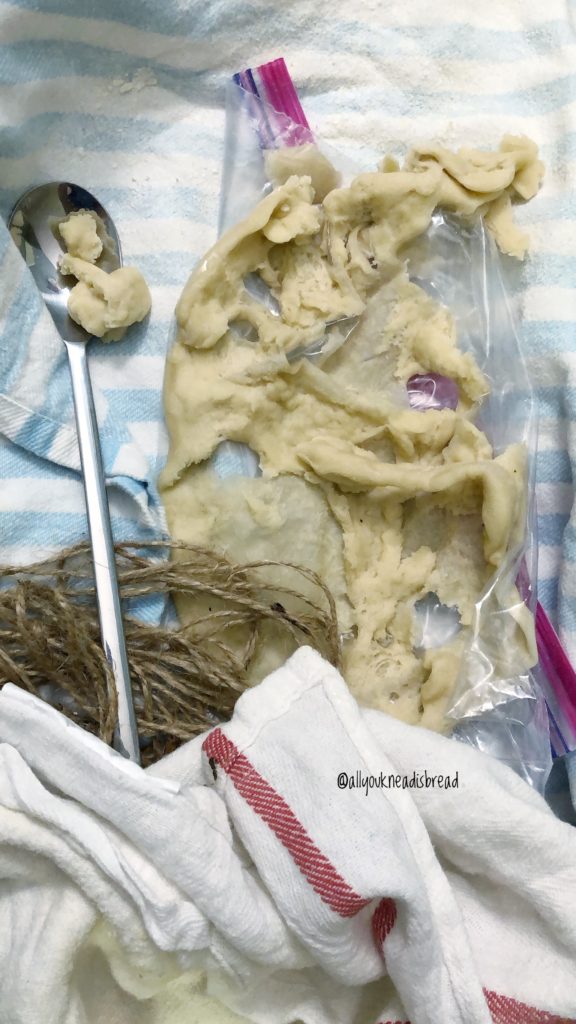
You will need:
- A knife
- A scale
- 200 g of stiff sourdough
- 200 g of flour
- 60-100 g of water at 30C/86F
- Mixing bowl
- Rolling pin
- A tall and transparent container
- Water for the bath
- Unwrap the log carefully
- With a knife cut the bag and open the log lengthwise. You should see small alveoli. The dough should have a dark color (from the apple water) and it should smell better, more of a fermentation smell than in the previous step.
- With a clean spoon, collect the inside part of the log (the “cuore” as Italians say). The strongest bacterial colony is in the core of the log. The bacteria undergo a very rough 48h where an anaerobic fermentation takes place and only the strong survive, and those are the ones we want.
- Collect 200g of dough or as many as you can.
- In a bowl add 200g of dough, 200g of flour and 30-50% of the weight of flour in water at 30C/86F. That is 60-100 g. Start by adding 30% and move up if needed. The dough should be dry and hard, it shouldn’t stick to the counter but should be soft enough to work with a rolling pin.
- Roll the dough into a rectangle, fold it in 2 or 3 and roll it again. The procedure is very similar to working with laminated dough.The dough should get smoother and smoother. It shouldn’t have pieces of dry flour in the middle.
- Roll the dough into a long rectangle that is slightly narrower than your container and about 1cm/0.5 in thick.
- Fold the rectangle into 3 or 4, put it inside of the plastic container and fill it with water just to cover the dough.
NOTES:
If your kitchen is:
- Cold-Very cold: you can use room temperature water for the bath
- Not too cold, not too warm (around 20-23C, 69-73F): you can use room temperature water and check how it evolves, you might be able to do refreshments every 12h or every 24.
- Warm-very warm: use cold water. Keep a bottle of water in the fridge, or cool it with ice cubes and when it’s cold enough add it to the container.
Pay attention to how the dough behaves. Warmer temperatures will accelerate the fermentation process and colder will slow it down. Avoiding over fermentation is crucial.
In my case, my kitchen was not too warm and not too cold, but since I’m not home all day, I didn’t want to risk the dough to over ferment and lose a lot of it, so I started using cold water. The dough didn’t show much sign of fermentation in the first 12h. After 16h it was floating and after 24 it had clear signs of fermentation (alveoli), the layers weren’t visible anymore and it had developed a dry skin on top.
Something I realized was that this sourdough starter likes routines, so try to always do the same thing and keep it at the same temperature. During this process, there was a night when the temperature dropped a lot and the pasta madre didn’t rise as usual. In my experience, consistency is key!
The reason the container and the dough should be almost the same width is that when the dough starts fermenting and the layers get thicker, the container will retain the dough and prevent it from expanding to the sides. Therefore, the dough doesn’t have a choice but to grow upwards.
Training your pasta madre: 10 days
Days 6-15: refresh the lievito madre every 12 or 24h
According to the Italian regulations for Artisanal Panettone, the lievito madre has to be trained for at least 7 days. In our case, it’ll be trained for 10 days.
From now on you need discipline because you must feed your LM at the very least every 24h. Whether you’re tired or sleepy. Therefore, you need to think well about which schedule works for you best.
For example, I leave my house around 8:45 am, and come back home around 8 pm, that’s my window. I started the process at 8:30 pm and then I was doing the refreshments at 8:30 pm every 24h. I chose this time because not only is it when I’m home, but it’s also a time that works for me on the weekends. Because your pasta madre doesn’t take weekends off!
I’m saying this because if you start working very early, you might do refreshments at 5 or 6 am, but… will you wake up that early on a weekend? If you will, then it’s fine! I know I wouldn’t, I’d probably turn my alarm off and regret it later.
You will need:
- A knife
- A scale
- 200 g of stiff sourdough
- 200 g of flour
- 60-100 g of water at 30C/86F
- Mixing bowl
- Rolling pin
- Tall and transparent container
- Water for the bath
- A large bowl to discard the water or the kitchen sink
I changed my container to a shorter but wider one after day 6 or 7. It allowed me to control and shape the dough better.
The procedure is similar to day 5.
After 24h, the lievito madre should’ve risen to the top of the container and probably developed a dry skin. In the bottom, you will see some flour. Your pasta madre will be very soft and slimy on the outer parts. What we need is the core of the dough.
- Remove the dry skin that developed on top. It might not be completely dry, but even so, remove it. It’s the part that has been exposed to dust and particles falling on top of it.
- Hold the container with one hand and with the other try to separate the dough from the walls of the container so the water to come out but you can hold the dough, and remove the water.
- Squeeze the dough to drain water out of it and massage it so the slimy mushy part falls out and you only keep the dough that was not degraded.
- In another bowl weigh 200g of Manitoba flour, add 200 g of the drained pasta madre and add 60-100 g of water at 30C/86F
- Knead everything and incorporate all the flour. If you need to let the dough rest, do so.
- Roll and shape the dough the same way you did the day before
- Place the dough in the container and add water to cover it.
Repeat this every day for the next 10 days paying attention to how the dough smells, how the alveoli look after the fermentation cycle etc. Also, smell everything. The dough, the water you discard… Your nose will let you know how the lievito madre is doing more than your eyes will.


Things you need to know
- You need to keep everything extremely clean to reduce the chance of cross-contamination.
- Keep in mind that you’re going to use a lot of flour just to build your starter. If you’re a pro at this, probably you can use smaller amounts of flour and LM because you can tell how the dough is doing just by looking at it. But if you’re like me, in the learning process, you might want to keep relatively large amounts of flour for each refreshment until you learn to feel the dough and see if it needs more or less water, 24 or 12h refreshment cycles, etc. I learned this method this way and larger amounts are easier to deal with and to avoid over-degradation of the dough. This is especially handy when you’re not home all day. I see this as an investment, from now on I’ll take care of my lievito madre and, hopefully, I won’t have to do it again!
- Your hand will suffer, keep your moisturizing lotion close by! After a few days I noticed my hands were getting very dry. I guess it’s normal, you’ll be washing your hands all the time, and let me tell you… this dough is difficult to get rid of! Warm water is your best friend here. Also, you’re going to be working every day with a slightly acidic dough. So yeah, keep the lotion close by.
- If you can find/afford 2 containers with the same dimension, get them. It’ll make the process a bit faster because you don’t have to stop to wash it to put the dough back in.
That is all for now!
This is all for now. If you have any questions you can contact me through email, DM on Instagram, or send me a message on Facebook and I’ll try my best to help you!
Let’s start a movement for homemade artisanal panettone! Tag your pics with the hashtag #missionpanettone so we can all see how everyone’s lievito madre is doing.
You can find me on Instagram, Facebook, and Pinterest, and you can also subscribe to my Youtube channel.
This post contains affiliate links and any sales made through such links will reward me a small commission – at no extra cost for you – that allows me to keep running this blog.
I hope you all have a wonderful weekend and if you are celebrating Thanksgiving… Happy Thanksgiving!
Maria.
Cheese and Cumin bread – Video

Hello friends!
Do you know when you buy an ingredient for a recipe, but you don’t have the recipe yet? That’s how this bread happened!
Strolling down the grocery store I found an English cheese and I knew I wanted to use it in a bread recipe. I could almost smell it! There are many recipes of loaves with cheese inside, breadsticks stuffed with cheese, etc. But I wanted to make something different.
In Spain, bread is always on the table and in my home, my parents always had a wedge of cheese. Every Friday evening, before dinner, my dad would slice some cheese and we’d all eat it with a piece of bread.
At that time, the local bakery started to make a new type of bread, it was called “torta de aceite”, it was a soft bread made with olive oil. The shape and texture were similar to focaccia, but without toppings and a more delicate crumb. We all loved that bread and we started to enjoy it every Friday evening with our cheese 😊
Then I thought… What if I make a similar type of bread with cheese on top? I was drooling just thinking about it.
I decided to add cumin seeds to this recipe because I also remember my parents used to buy a type of cheese with cumin seeds, and I loved that flavor combination! If you haven’t tried it yet, I encourage you to do so and see if you like it too. But if you don’t like cumin, you can skip it or change it by something you like better.

This bread has an intense aroma and is very soft, with a delicate crumb. You can use it to accompany meals, or as an appetizer, or even as a snack on a Friday evening 😊
The egg and olive oil add fat to the dough and this allows the bread to be very soft and last fresh for several days, although I doubt it’ll last too long!
So, without further ado, let’s get to the recipe!
First, as always, we need to activate the yeast. In this case, I added some sugar to feed the yeast.
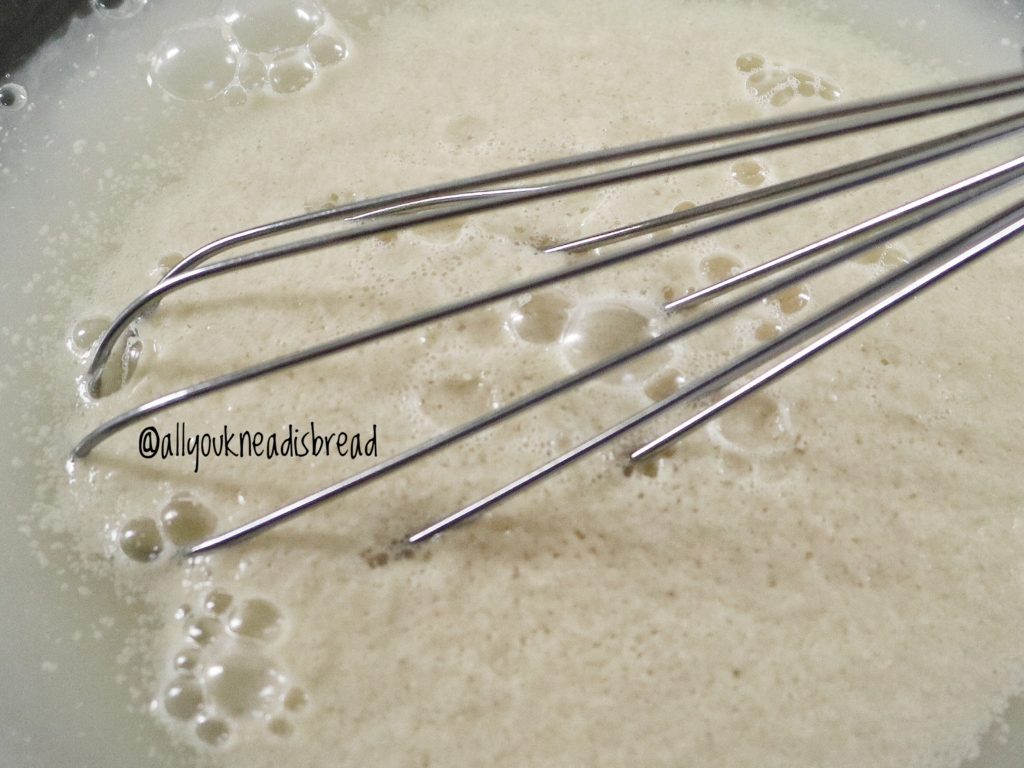
Then we mix in the egg and cumin seeds and combine very well.
NOTE: you can add the oil to the wet ingredients now, I prefer to add it later because I think the crumb turns out spongier. But that’s my preference. Just make sure you knead the dough well.
Now we let the dough hydrate for a few minutes before we start kneading.

Add the oil and incorporate it very well. Then knead the dough until it’s soft, elastics, and shiny.

Let the dough rise until it has doubled or tripled in size

Deflate the dough well and let it rest 20 mins.
Shape the dough. You can shape it into a circle, a rectangle… whatever you prefer!
Cut the cheese and put it on top of the dough. I used an aged cheese, and that’s what I’d recommend. I wouldn’t use shredded cheese because: 1) it’ll burn and 2) it doesn’t have the strong aroma of aged cheese.
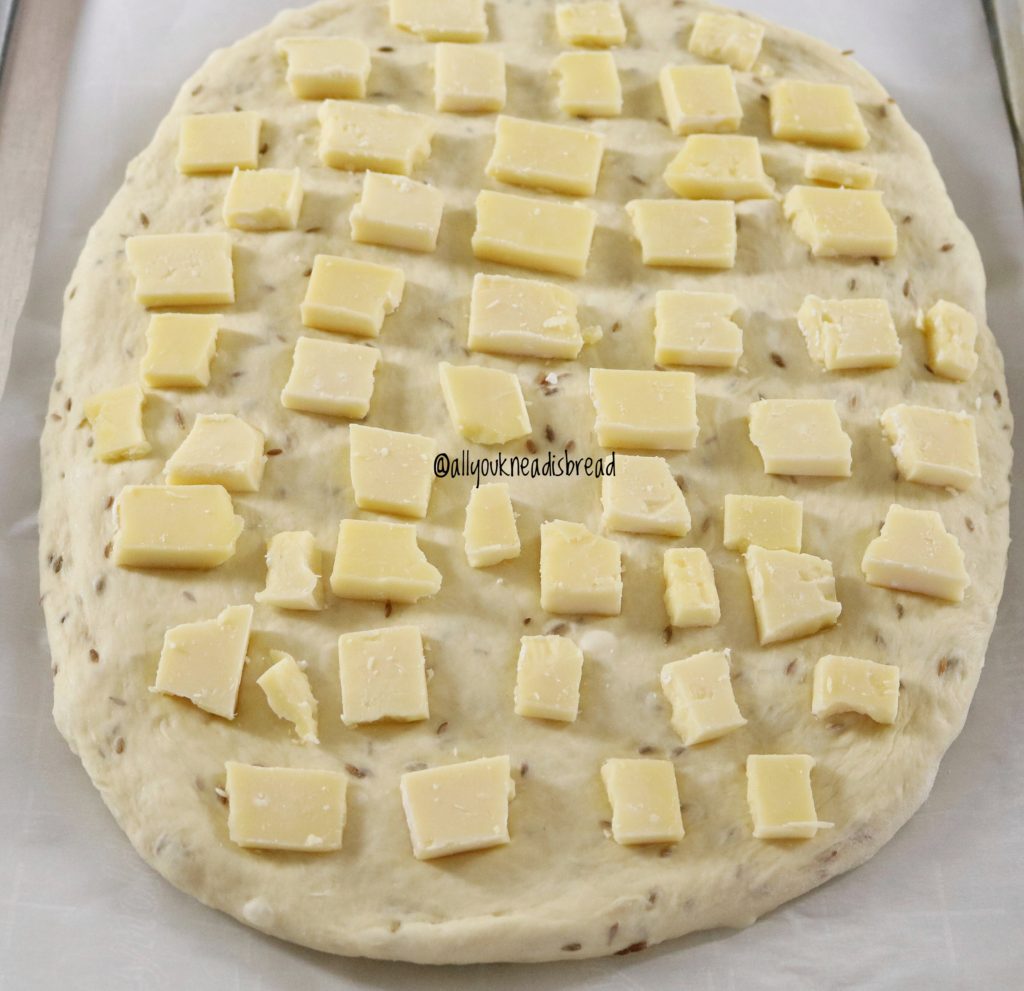
NOTE: if you prefer a flatter bread, shape it thinner and make sure you pierce large air pockets.
Cover the dough with a clean cotton cloth and preheat your oven at 360F for about 20 mins
This will be the time we’ll let the dough rise, when the oven is ready, brush the bread with egg wash and bake it for 30 mins or until it’s done and has a deep golden brown color.
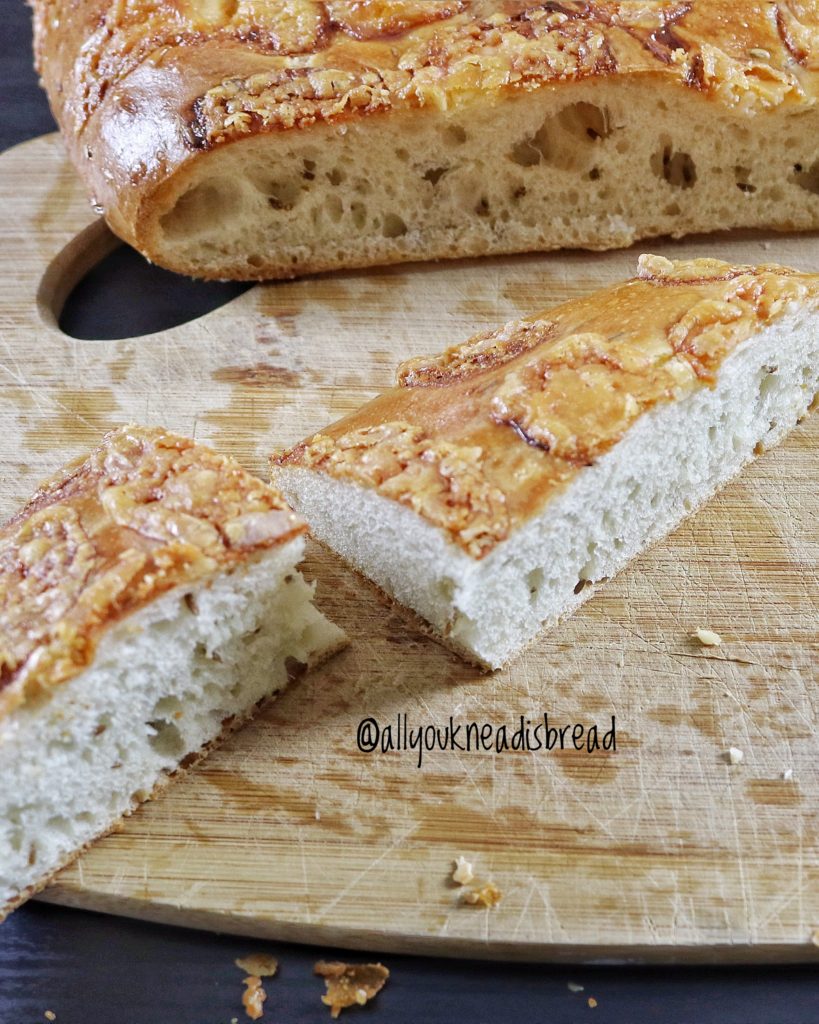
Your kitchen is going to smell heavenly!
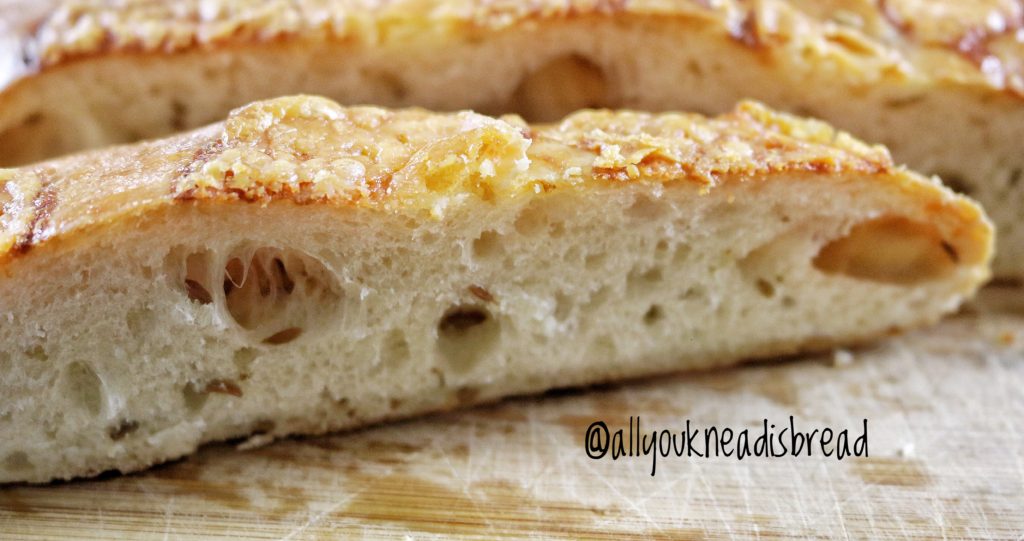
When the bread is ready let it cool down on a cooling rack… If you can!
Let me know what you think about this recipe and if you like it, thumbs up on the video and subscribe to my channel!
Happy baking!

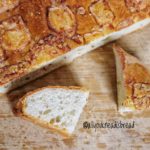
Chese and cumin bread
Ingredients
- 450 g bread flour
- 250 g water
- 5 g active dry yeast
- 1 egg L
- 1 tbsp sugar
- 7 g salt
- 40 g olive oil extra virgin for a more intense flavor
- 5 oz aged cheese
- 1 tbsp dry cumin seeds
- 1 egg for egg wash
Instructions
-
Dissolve sugar in water, add the yeast and whisk it together. Let it rest 5-10 mins
-
Add salt, egg and cumin seeds to the yeast mixture and combine well
-
Sift the flour into a bowl and add the wet ingredients
-
Combine all ingredients until you don't see dry flour particles and let it rest for 20-30 mins
-
Add the oil and incorporate
-
Knead until the dough is elastic, shiny and full of blisters and let it ferment until it doubles in size
-
Deflate the dough well and let it rest a 15 minutes before the final shape
-
Cut the cheese block into thin pieces
-
Preheat your oven ar 360 F
-
Shape the dough into a 1/2 inch oval and place the cheese bits on top
-
Let the dough ferment while the oven preheats
-
Brush with egg wash and bake for 30 mins or until it's golden brown
Russian Kefir Bread – Video
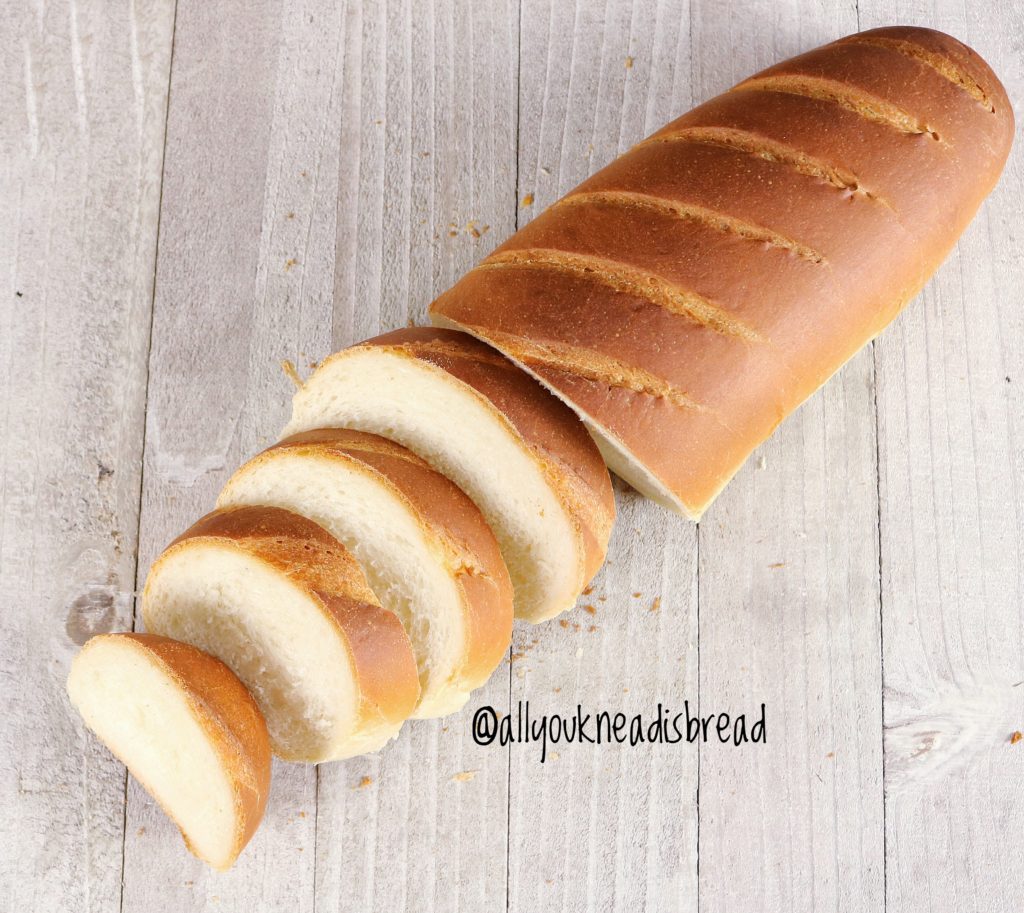
Well well well… Looks like summer is already here! One of the things I like of the crazy weather we have in NC is the summer storms. I find rain quite relaxing, the trickling sound of the water, the smell of wet soil, the sunset of a stormy day… And baking while raining? That’s a complete spa day!
I guess many of you will go on a vacation this summer, but if for some reason you won’t, I’d like to take you on a little trip without leaving your kitchen! I’d like to take you to the Caucasus region!
This region is well known for their kefir. A fermented milk drink made from kefir grains. These grains are a combination of yeasts and bacteria that you add to milk. The culture ferments overnight, and the next morning you have your fresh fermented drink! The consistency is similar to drinkable yogurt. A little bit sour because of the lactic acid bacteria. While I’m not an expert on homemade kefir, I believe you can control the sourness by controlling the fermentation temperature and times.
Kefir has gained much attention in the last years because it’s a probiotic, so it’s very healthy for your gut microbiota and digestive system. Now you can find it in almost all grocery stores!
I came to realize that almost every country and region have a bread recipe that uses local ingredients or cooking techniques, so in Eastern European countries, kefir is sometimes used to make “батон” (baton) bread. I guess the name comes from the shape of the bread.
I’ve been doing some research on this recipe, I’ve looked for blogs and videos (Thank you Google translate!) and I finally found a recipe that I like, although I’ve made a few changes.
This bread is very easy to make and it the perfect candidate to start kneading by hand. This dough is on the dry side, therefore comes together pretty fast. It’s great to try different kneading techniques and develop your own style. I think making this bread can also be an excellent activity to do with your kids, the recipe it’s simple, they can help you knead, and they won’t make a mess because the dough is not very sticky! 😉
You can eat this kefir bread with savory dishes, or jam, or just plain! And it makes wonderful French toasts too! The flavor is rich and delicate, and the kefir really gives the bread an interesting kick and aroma! The crumb is perfectly fluffy and cohesive, and the crust is not too thick, so you can use this recipe to make homemade subs! The crust will get softer after a few hours. And in my opinion, the aroma of the bread is better after it cooled down completely.
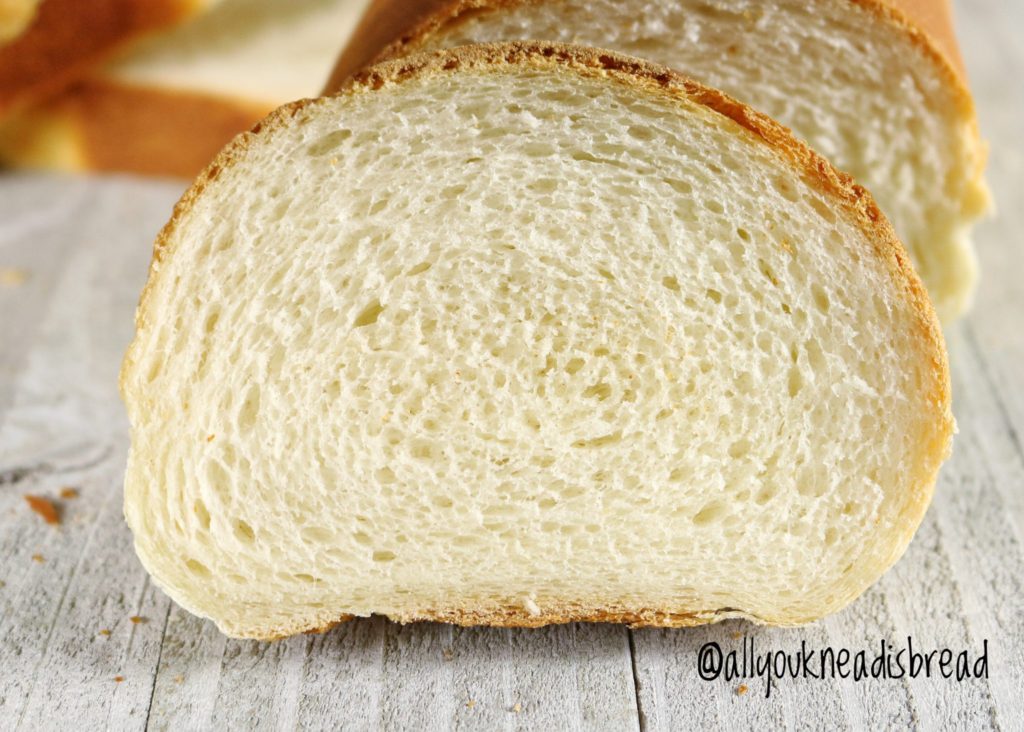
The recipe yields 3 large loaves or 4 medium loaves, so if you’re not going to eat them all you can freeze some and keep the rest in a Ziplock bag for a few days.
Let’s start with the recipe!
As always, activate the yeast in the water and let it sit for a few minutes.
Once the yeast is active, add sugar, salt, kefir and butter and give it a good whisk. Don’t worry if there are chunks of butter.
Then add 1/3 of the flour and combine everything very well until you have a thick paste. By doing this, incorporating the butter will be easier and you don’t have to melt it. Bread usually turns out better if you don’t melt the butter.
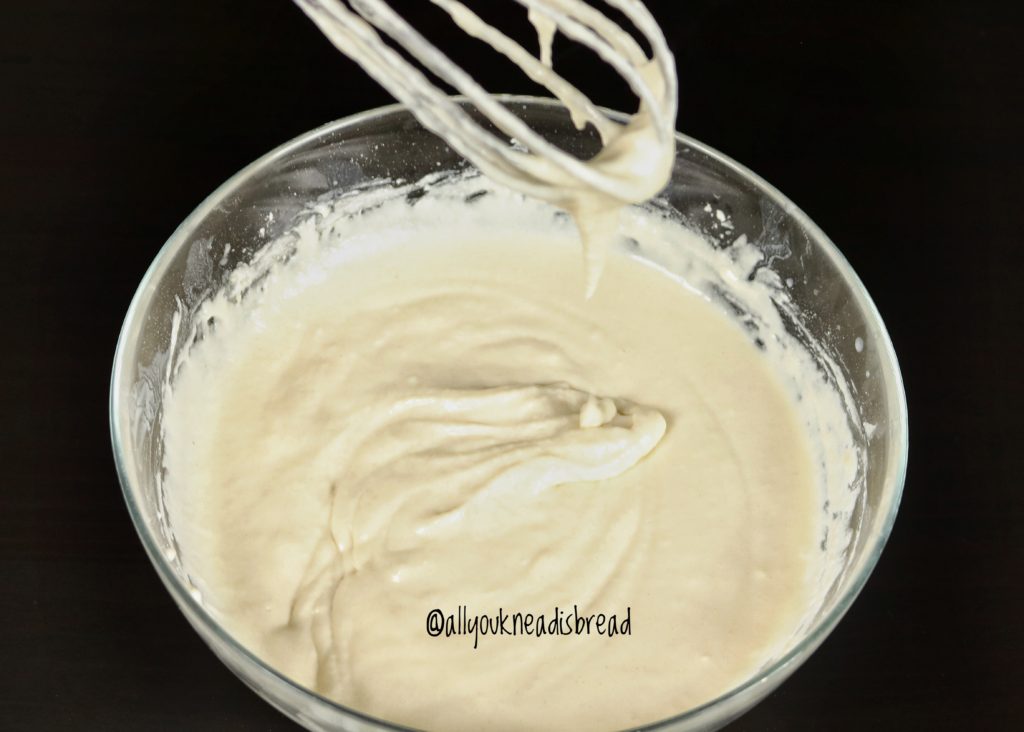
Add the paste to the rest of the flour (previously sifted) and combine all the ingredients together until there are no dry flour particles.
Let the dough rest for 20-30 minutes to allow the flour particles to hydrate. This is a pretty dry dough, since the gluten doesn’t have much moisture, it’s important to start working the dough after the gluten proteins had some time to hydrate.
Knead the dough until it’s soft and elastic. Knead it the best way you can with the technique you’re more comfortable with. The dough feels a little hard at the beginning, use the heel of your hand to apply pressure and eventually it’ll become more elastic. Be patient, it’ll take about 15 minutes to have the dough ready.

After autolysis 
After kneading
You shouldn’t need extra flour to knead the dough, it’s not sticky, but if you do, try not to add too much or your bread will turn out too dry.
When the dough is ready, let it ferment until it doubles in size and it’s puffy. In a warm environment it will take between 1 h and 1 h 30 mins.
After that, deflate the dough very well, we’re not looking for big alveoli in the crumb, but a bun-like crumb.
Divide the dough into 4 equal pieces (or as many as you want! It depends on how large you want the loaves). Shape them into balls and let them rest, covered, for 10 minutes. During this time the gluten strands will relax, and it’ll be easier to shape the loaves.
To shape the loaves, flatten each dough ball with your hand and with a rolling pin roll them into a rectangle as wide as you’d like the loaves. The rectangle should be about 1/3 or 1/4 of an inch (0.5-0.8 cm).

You can use some flour while you shape the loaves to avoid the dough from sticking on the counter.
Once you have the rectangle start rolling the dough from the narrowest side, tugging the ends inside of the log.
Let the loaves rest, covered, until they double in size. Before the proofing time is over, preheat your oven at 375 F (190 C).

Right before baking the loaves, make cuts through them and brush some water. This step is optional, the water will help develop the crust but if you prefer a softer crust, don’t brush it.
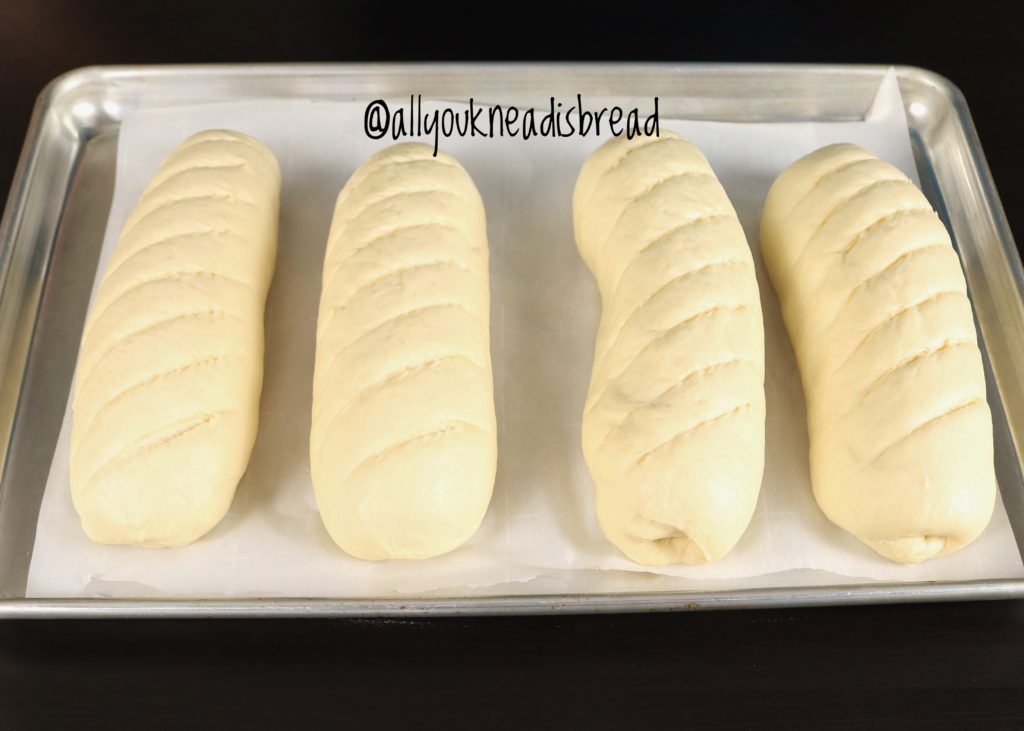
Bake the loaves for 25 minutes or until they are golden brown
NOTE: you might need to bake at lower temperature to make sure the loaves are fully cooked. You know your oven better!
When the loaves are ready, let them cool down on a cooling rack. I know it’s tempting but try to wait until the bread is at room temperature so the crumb finish baking and the aromas finish developing.
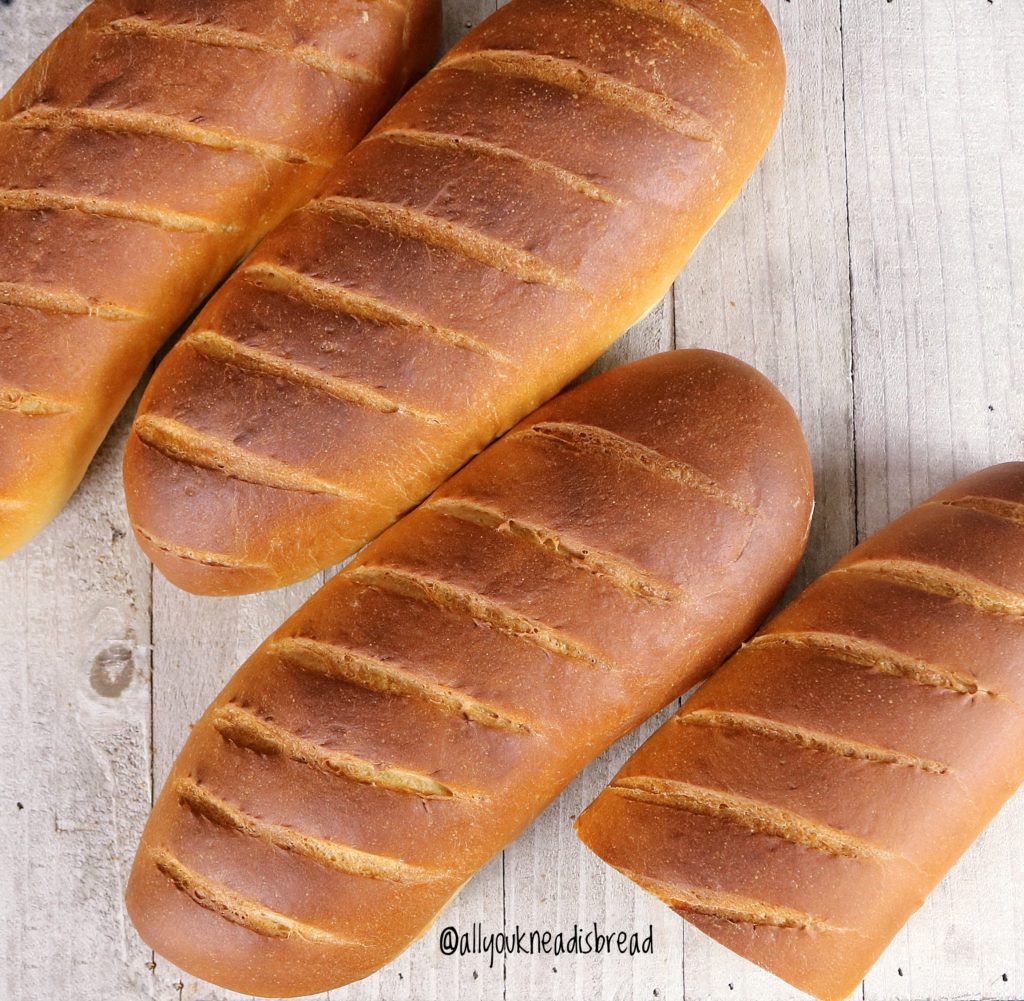
Enjoy!
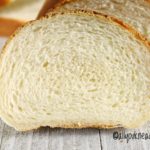
Russian Kefir Bread
A delicious and easy bread recipe
Ingredients
- 600 g bread flour sifted
- 175 g plain kefir
- 175 g water room temperature
- 6 g dry yeast
- 10 g salt
- 30 g white sugar
- 50 g unsalted butter softened
Instructions
-
Dissolve the yeast in the water and let it sit for 10 minutes
-
Add to the yeast mixture the salt, sugar, kefir, butter, and 200 g of flour and combine everything until you get a paste.
-
Add the paste to the leftover flour and incorporate all the ingredients until there are no dry flour particles. Let it sit, covered, for 20 minutes
-
Knead the dough until it's elastic and soft
-
Place the dough on a lightly oiled bowl and let it ferment, covered, until it doubles in size and it's puffy.
-
Deflate the dough and knead it for 1 or 2 minutes to make sure you get rid of big bubbles
-
Divide the dough in 4 equal pieces. Shape them into balls, cover them and let them rest for 10 minutes.
-
With a rolling pin roll the balls into a rectangle and shape the loaves.
-
Let the loaves rest, covered, until they double in size and they are puffy.
-
Make cuts on the loaves, brush them with water (optional) and bake them at 375 F for 25 minutes or until they're golden brown










